EnGenius Technologies EAP1200H 2.4GHz b/g/n, 5GHz ac/a/n Indoor AP User Manual Users manual
EnGenius Technologies 2.4GHz b/g/n, 5GHz ac/a/n Indoor AP Users manual
Users manual.pdf
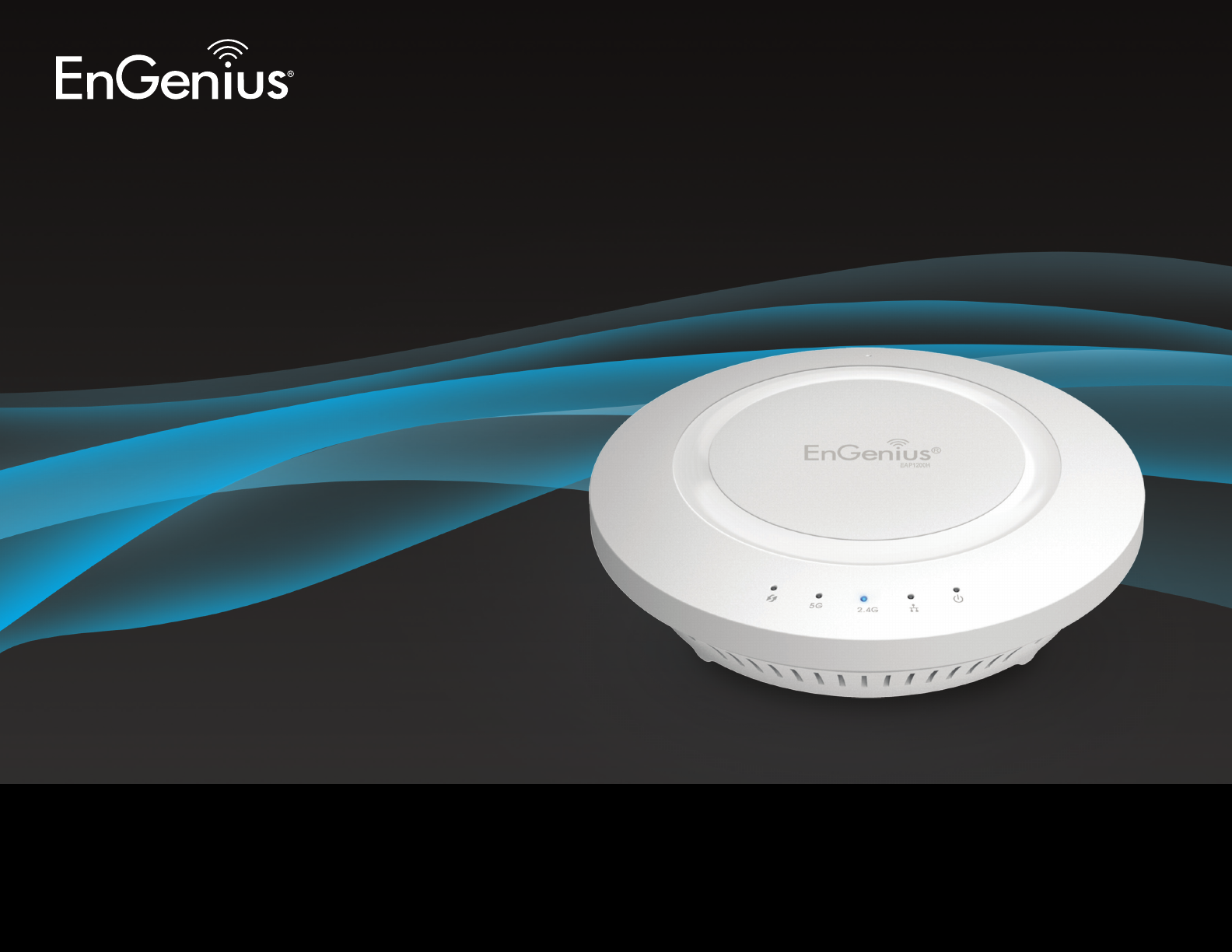
User Manual
Business Solutions
Dual Band AC1200 Indoor Access Point
Ceiling Mount Design
EAP1200H
version 1.0
2
IMPORTANT
To install this Access Point please refer to the
Quick Installation Guide included in the product packaging.
3
Chapter 1 Product Overview................................................... 4
Key Features/Introduction........................................................... 5
System Requirements / Package Contents .............................. 6
Applications...................................................................................... 7
TechnicalSpecications...............................................................8
Physical Interface........................................................................... 9
Chapter 2 Before You Begin .................................................. 10
Considerations for Wireless Installation............................. 11
Computer Settings..................................................................... 12
Hardware Installation................................................................. 15
Mounting the EAP1200H............................................................. 16
Chapter 3 Conguring Your Access Point.......................... 18
Default Settings............................................................................ 19
Chapter 4 Building a Wireless Network............................. 20
Access Point Mode....................................................................... 21
WDS AP Mode............................................................................... 22
WDS Bridge Mode........................................................................ 23
Chapter 5 Overview............................................................... 24
Overview........................................................................................... 25
Connections.................................................................................... 26
Chapter 6 Network ................................................................. 27
OperationMode/Basic...................................................................28
IP Settings/SpanningTree Settings...................................... 29
Chapter 7 Wireless ............................................................... 31
Wireless Network........................................................................ 31
Wireless Security......................................................................... 34
Guest Network Settings......................................................... 39
Fast Roaming............................................................................... 40
Fast Handover............................................................................. 40
Wireless MAC Filtering............................................................ 41
Wireless Advanced...................................................................... 42
WPS (Wi-Fi Protected Setup)................................................. 43
WDS Link Settings....................................................................... 44
Chapter 8 Management........................................................ 45
Administration.............................................................................. 46
Management VLAN Settings................................................. 47
Wireless Trafc Shaping......................................................... 48
SNMP Settings............................................................................... 49
Backup/Restore.......................................................................... 51
Auto Reboot Settings................................................................ 52
Firmware Upgrade/Time Settings............................................ 53
System Log/Tools.......................................................................... 55
Ping Test Parameters/Traceroute Parameters.................. 56
Speed Test Parameters/LED Control.........................................57
Device Display/Reset...................................................................58
Appendix ................................................................................. 59
FCC Interference Statement.................................................. 60
CE Interference Statement...................................................... 61
Table of Contents

4
Chapter 1
Product Overview
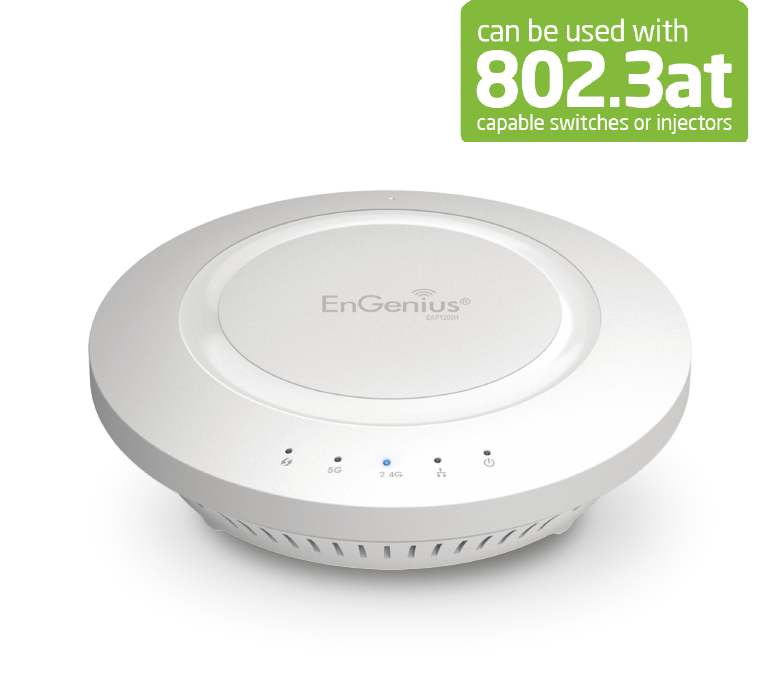
5
Maximum data rates are based on IEEE 802.11 standards. Actual throughput and range may vary depending on many factors including environmental conditions, distance between
devices, radio interference in the operating environment, and mix of devices in the network. Features and specications subject to change without notice. Trademarks and registered
trademarks are the property of their respective owners. For United States of America: Copyright © 2015 EnGenius Technologies, Inc. All rights reserved.
Key Features
• Upto26dBmtransmitpower,enablinglongrangeconnectivity
• SupportsIEEE802.11ac/a/b/g/nwirelessstandardswithupto
300Mbps(2.4GHz)and867Mbps(5GHz)
• Fourinternal5dBiOmni-DirectionalMIMOantennas
• CanbemonitoredafterdeploymentwithEnGeniusEZ
Controller™ software for Windows
(Free online download)
• CanbeusedwithincludedpoweradapterorviaPoEwithPoE
802.3at-capableSwitchesorInjectors
• DualBand/TwoStream
• BandSteeringshiftsdualbandclientsto5GHzforbetter
throughput performance
• SecuredGuestNetwork
Introduction
TheEAP1200Hisahigh-powered,long-range,Dual-band
concurrent Wireless 802.11ac/a/b/g/n Access Point with
three major functional modes. It is designed to operate
in numerous environments; from large homes, small and
medium-sized businesses, multiple-oor ofces, hotels,
and other venues, to larger enterprise deployments. Its
high-powered, long-range characteristics make it a cost-
Introduction
effective alternative to ordinary Access Points that don’t
have the range and reach to connect to a growing number
of wireless users who wish to connect to a large home or
business network.
6
The EAP1200H supports the 2.4 GHz frequency band under
the802.11b/g/nmodewhileatthesametimeprovidinga
5GHzbandforcommunicatingortransferringlesinaless
congested network frequency band.
The EAP1200H also delivers faster wireless speeds
comparedtomodern802.11a/b/g/nwirelessdevices.Even
though the EAP1200H has been designed and engineered
for heavy trafc and demanding business environments,
inlargerhousingenvironmentsasitcanefcientlyextend
thewirelessrangeofanexistinghomerouter.Thismakes
itespeciallyidealinarchitecturally-challengingstructures,
providing whole home connectivity.
To protect sensitive data during wireless transmissions,
the EAP1200H offers different encryption settings for
wireless transmissions, including industry standard WPA
and WPA2 encryption. The EAP1200H also includes MAC
addresslteringtoallownetworkadministratorstooffer
network access only to known computers and other devices
based on their MAC addresses.
System Requirements
The following are the Minimum System Requirements in
ordercongurethedevice:
• ComputerwithanEthernetinterfaceorwirelessnetwork
capability
• WindowsOS(XP,Vista,7,8),MacOS,orLinux-basedoperating
systems
• Web-BrowsingApplication(i.e.:InternetExplorer,Firefox,
Chrome,Safari,oranothersimilarbrowserapplication)
Package Contents
The EAP1200H package contains the following items (all
itemsmustbeinpackagetoissuearefund):
• EAP1200HAccessPoint
• PowerAdapter
• RJ-45EthernetCable
• QuickInstallationGuide
• CeilingandWallMountScrewkit
7
Applications
Wireless LAN (WLAN) products are easy to install and
highlyefcient.Thefollowinglistdescribessomeofthe
many applications made possible through the power and
exibilityofWLANs:
• Difcult-to-Wire Environments: There are many situations where
wirescannotbeinstalled,deployedeasily,orcannotbehiddenfrom
view. Older buildings, sites with multiple buildings, and/or areas
that make the installation of a Ethernet-based LAN impossible,
impracticalorexpensivearesiteswhereWLANcanbeanetwork
solution.
• Temporary Workgroups: Create temporary workgroups/networks
inmoreopenareaswithinabuilding;auditoriums,amphitheaters
classrooms, ballrooms, arenas, exhibition centers, or temporary
ofceswhereonewantseitherapermanentortemporaryWireless
LAN established.
• The Ability to Access Real-Time Information: Doctors/Nurses,
Point-of-Sale Employees, and/or Warehouse Workers can access
real-time information while dealing with patients, serving
customers,and/orprocessinginformation.
• Frequently Changing Environments: Set up networks in
environments that change frequently (i.e.: Show Rooms,
Exhibits,etc.).
• Small Ofce and Home Ofce (SOHO) Networks: SOHO users
require a cost-effective, easy, and quick installation of a small
network.
• Wireless Extensions to Existing Ethernet-based Networks:
Devices like the EAP1200H enable network administrators,
installers, and end-users to extend the range and reach of an
existingEthernet-basednetwork.
• Training/Educational Facilities: Training sites at corporations or
students at universities use wireless connectivity to exchange
information between peers and easily access information for
learning purposes.
8
Security
WEP(64/128bit)
WPA/WPA2 (TKIP/AES)
Hidden ESSID
MACaddressltering,upto50elds
L2 Isolation
802.1XAuthenticator(MD5/TLS/TTLS/PEAP)
Guest Network
QoS (Quality of Service)
WMM (Wireless Multimedia)
Physical/Environment Conditions
Operating:
Temperature:32°Fto104°F(0°Cto40°C)
Humidity(Non-condensing):90%orless
Storage:
Temperature:-4°Fto140°F(-20°Cto60°C)
Humidity(Non-condensing):90%orless
Standard:
IEEE802.11b/g/non2.4GHz
IEEE802.11ac/aon5GHz
IEEE802.3at
Antenna
Four Internal 5 dBi Omni-Directional Antennas
Physical Interface
1x10/100/1000GigabitEthernetPort
1xResetButton
1xPowerConnector
LED Indicator
Power
WPS
WLAN (Wireless Connection)
LAN
Power Requirements
ExternalPowerAdapter
DCIN,12V/2A
Operation Modes
Access Point
WDS AP
WDS Bridge
Technical Specications
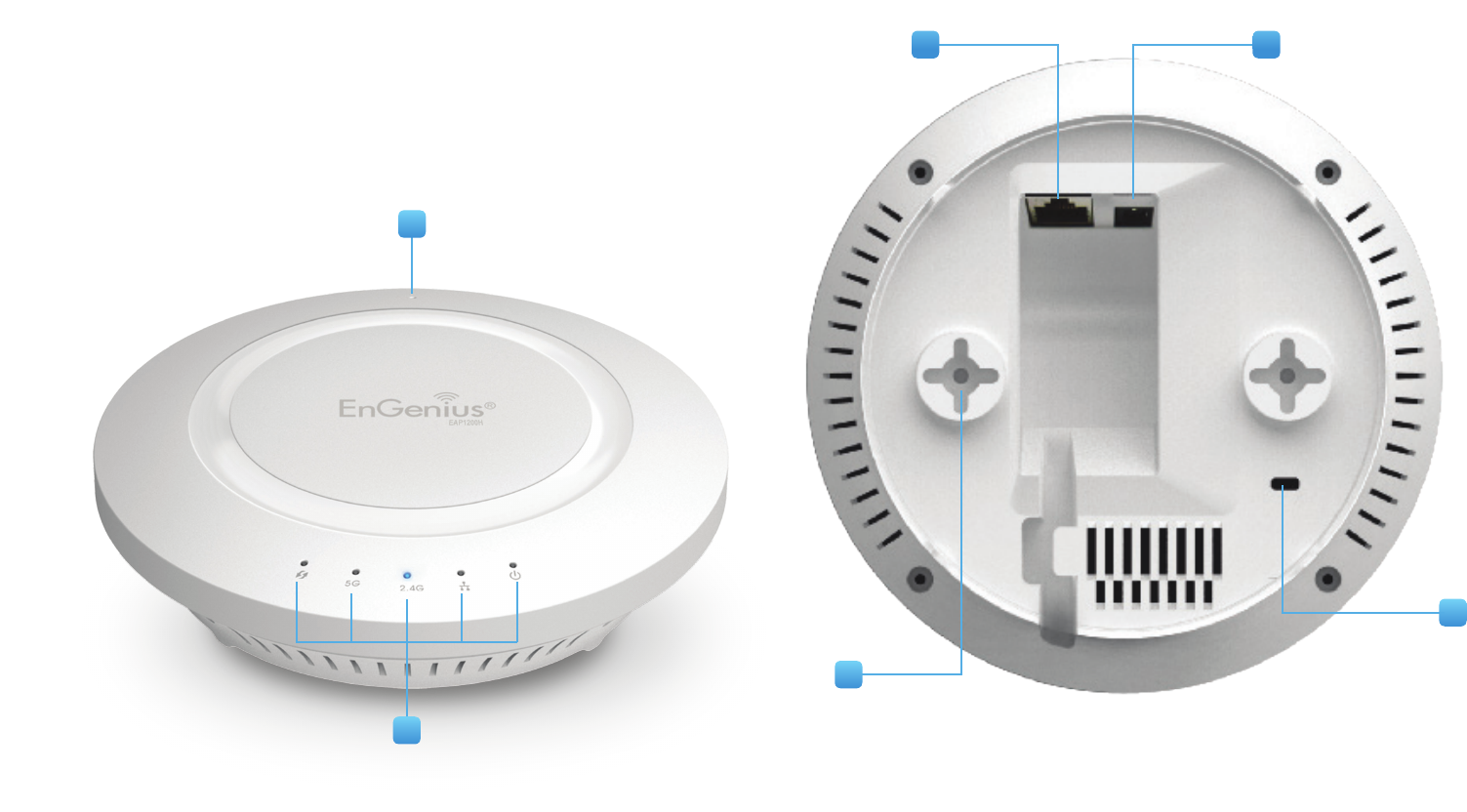
9
Physical Interface
Dimensions and Weights
Diameter:6.36”
Height:2.17”
1 Reset Button: Press and hold for over 10 seconds to reset to
factory default settings.
2 LED Indicators: LED lights for WPS, WLAN 5G, WLAN 2.4G,
Ethernetport,andPower
3 LAN Port (802.3at PoE): EthernetportforRJ-45cable.
4 Power Connector: 12V DC IN for Power.
5 Ceiling (Wall) Mount Hole: Using the provided hardware, the
EAP1200H can be attached to a ceiling or wall.
6 Kensington Security Slot: ToprotectyourEAP1200H,usethe
Kensington Security Slot to attach a cable lock.
3 4
1
2
5
6
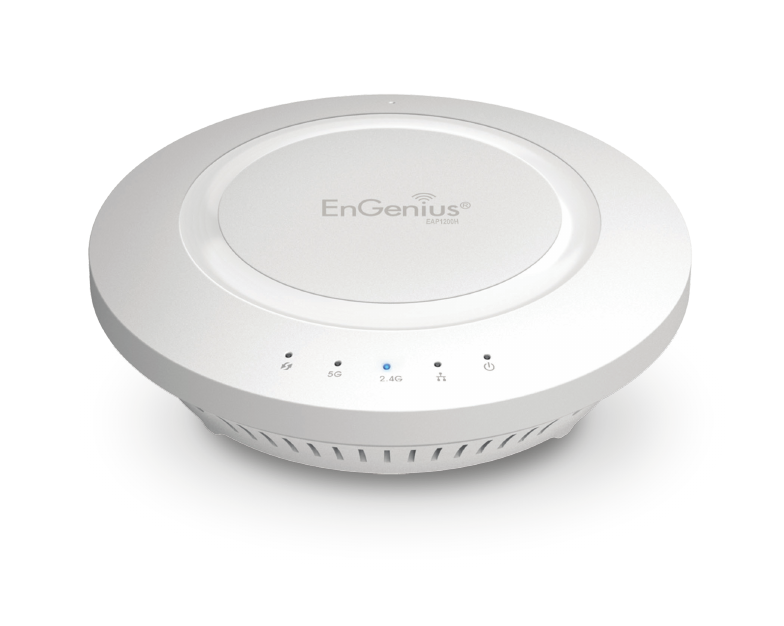
10
Chapter 2
Before You Begin
11
This section will guide you through the installation process.
Placement of the EnGenius EAP1200H is essential to
maximizetheAccessPoint’sperformance.Avoidplacing
the EAP1200H in an enclosed space such as a closet,
cabinet,orstairwell.
Considerations for Wireless Installation
The operating distance of all wireless devices can often
not be pre-determined due to a number of unknown
obstacles in the environment in which the device is
deployed. Obstacles such as the number, thickness,
andlocationofwalls,ceilings,orotherobjectsthatthe
EAP1200H’s wireless signals must pass through can
weaken the signal. Here are some key guidelines for
allowing the EAP1200H to have an optimal wireless
range during setup.
• Keepthenumberofwallsand/orceilingsbetweentheEAP1200H
and other network devices to a minimum. Each wall and/or ceiling
canreducethesignalstrength,resultinginaloweroverallsignal
strength.
• Buildingmaterialsmakeadifference.Asolidmetaldoorand/or
aluminum stubs may have a signicant negative effect on the
signal strength of the EAP1200H. Locate your wireless devices
carefully so the signal can pass through drywall and/or open
doorways.Materialssuchasglass,steel,metal,concrete,water
(example:shtanks),mirrors,lecabinets,and/orbrickcanalso
diminish wireless signal strength.
• Interferencefromyourotherelectricaldevicesand/orappliances
that generate RF noise can also diminish the EAP1200H’s signal
strength. The most common types of devices are microwaves or
cordless phones.
Before You Begin
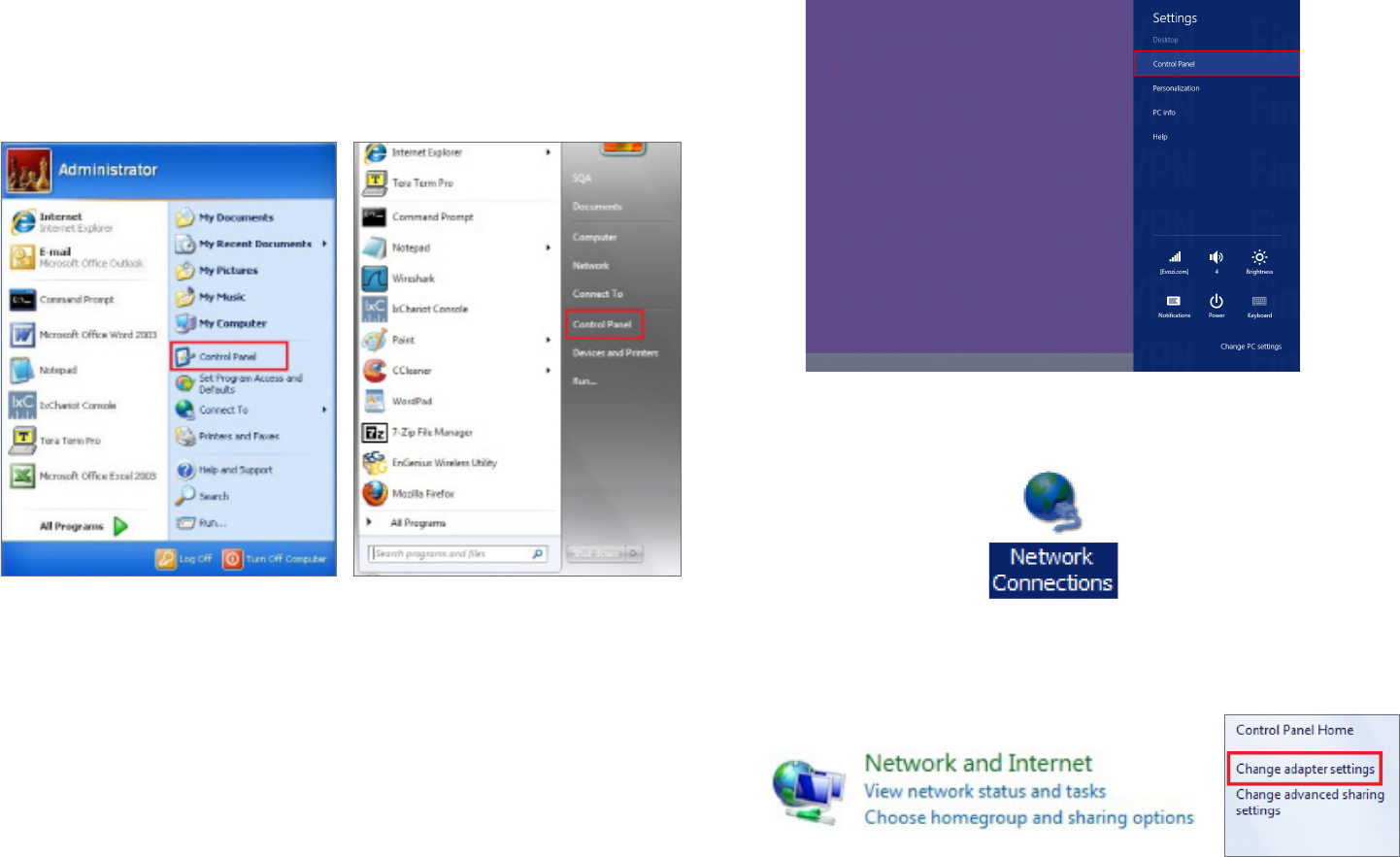
12
Windows XP/Windows 7/Windows 8
InordertousetheEAP1200H,youmustrstcongurethe
TCP/IPv4 connection of your Windows OS computer system.
1a.InWindowsXPandWindows7,clickthe Start button
and open the Control Panel.
1b.InWindows8,moveyourmousetothelowerrighthot
corner to display the Charms Bar and select the Control
Panel.
2a. In Windows XP, click on Network Connections.
2b. In Windows 7 and Window 8, click View Network
Status and Tasks in the Network and Internetsection,
then select Change Adapter Settings.
Computer Settings
Windows XP Windows 7
Windows 8
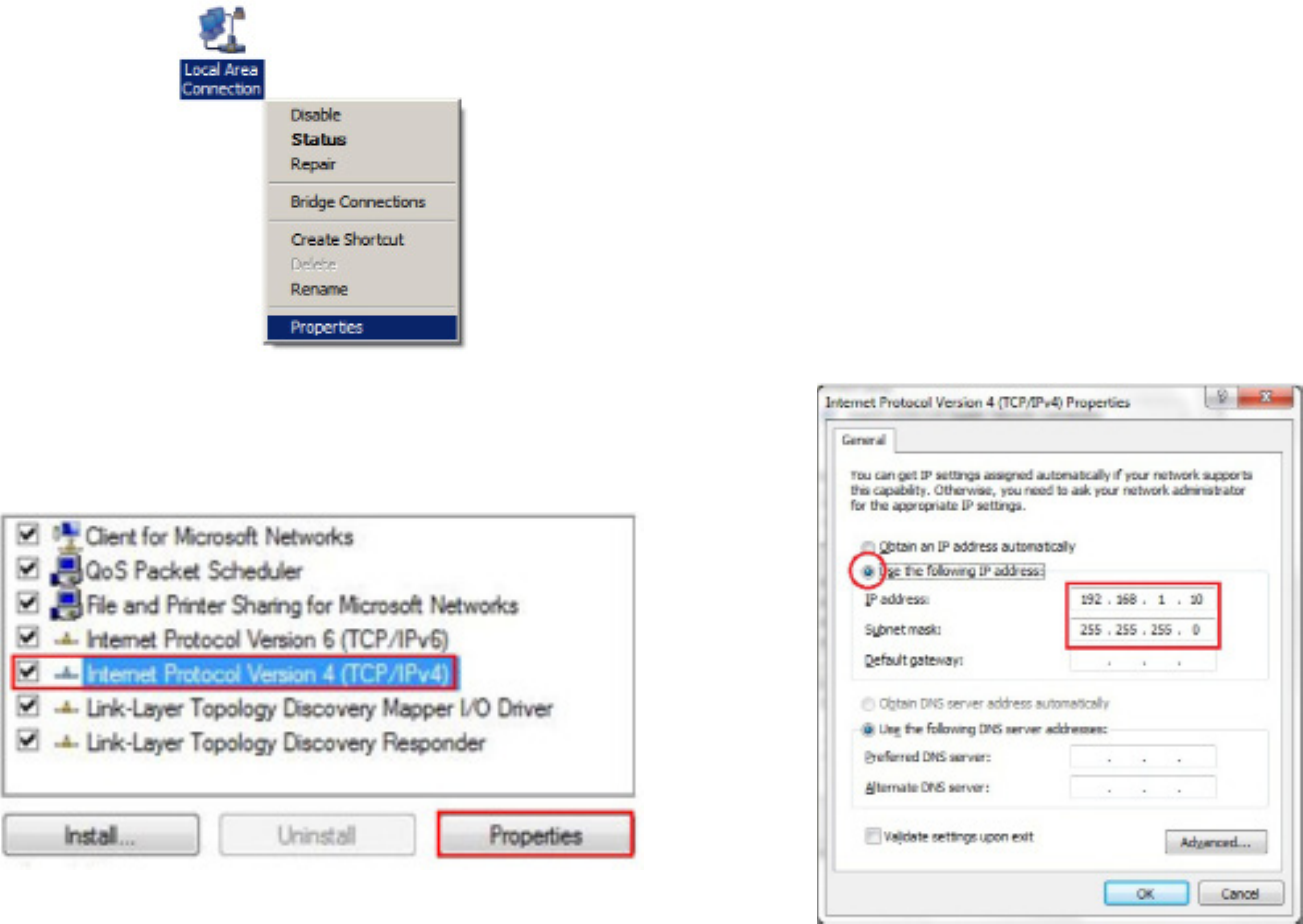
13
3. Right click on Local Area Connection and select Properties.
4. Select Internet Protocol Version 4 (TCP/IPv4) and then
select Properties.
5. Select Use the following IP address and enter an IP
address that is different from the EAP1200H and Subnet
mask,thenclickOK.
Note: Ensure that the IP address and Subnet mask are
on the same subnet as the device.
Forexample:EAP1200HIPaddress:192.168.1.1
PCIPaddress:192.168.1.2–192.168.1.255
PCSubnetmask:255.255.255.0
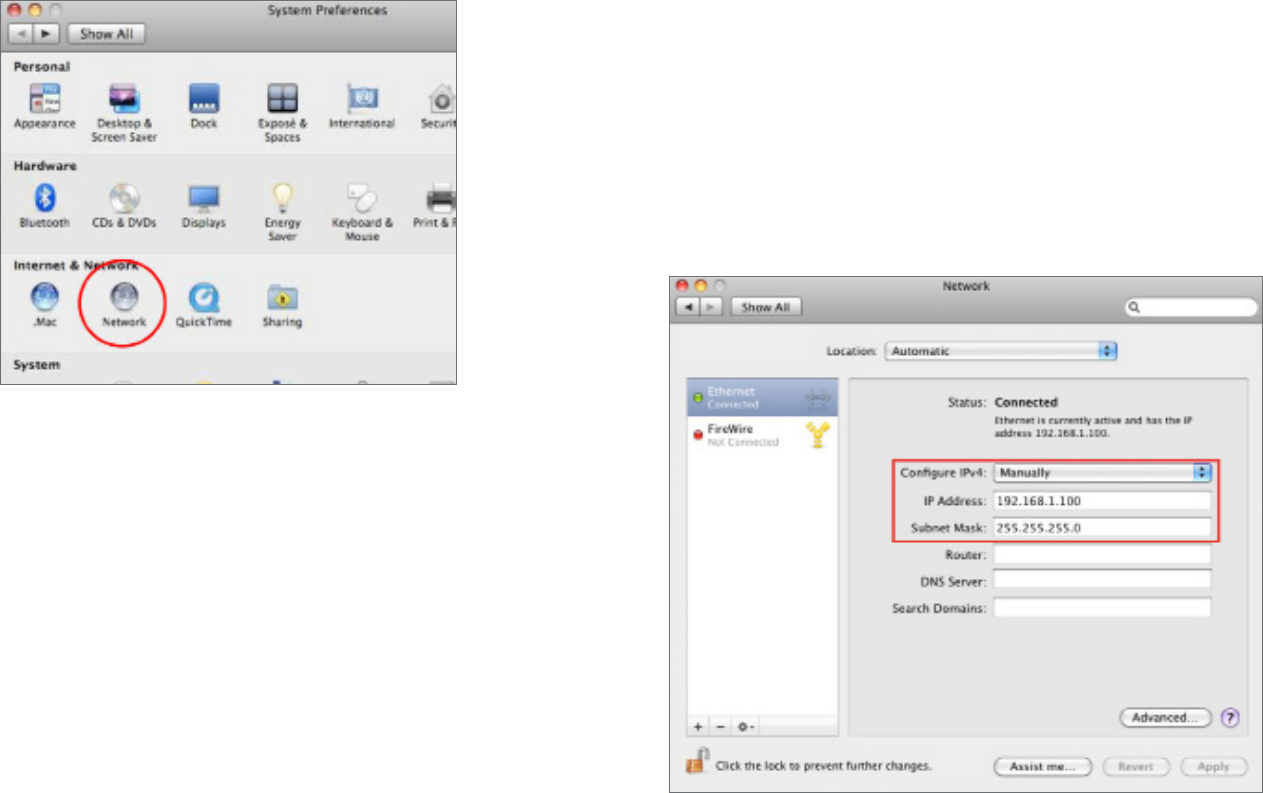
14
Apple Mac OS X
1. Go to System Preferences (it can be opened in the
Applications folder or by electing it in the Apple Menu).
2. Select Network in the Internet & Network section.
3. Highlight Ethernet.
4. In Congure IPv4,selectManually.
5. Enter an IP address that is different from the EAP1200H
andSubnetmask,thenclickOK.
Note: Ensure that the IP address and Subnet mask are
on the same subnet as the device.
Forexample:EAP1200HIPaddress:192.168.1.1
PCIPaddress:192.168.1.2–192.168.1.255
PCSubnetmask:255.255.255.0
6. Click Applywhennished.
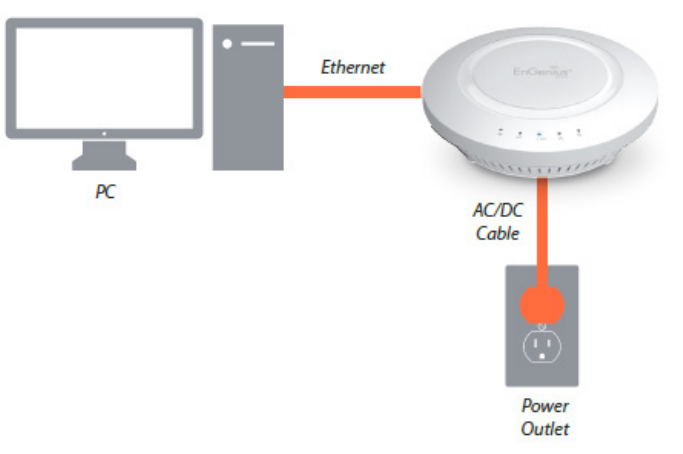
15
1. Ensure that the computer in use has an Ethernet
Controller port (RJ-45 Ethernet Port). For more
information,verifywithyourcomputer’susermanual.
2. Connect one end of the Category 5e Ethernet cable into
theRJ-45portoftheEAP1200Handtheotherendto
theRJ-45portofthecomputer.Ensurethatthecable
is securely connected to both the EAP1200H and the
computer.
3. Connect the Power Adapter DC connector to the DC-IN
port of the EAP1200H and the Power Adapter to an
available electrical outlet. Once both connections are
secure,verifythefollowing:
a) Ensure that the POWER light is on (it will be orange).
b) Ensure that the 2.4 GHz/5 GHz WLAN light is on (it will
be bluefor2.4G,andgreen for 5G).
c) Ensure that the LAN (Computer/ EAP1200H
Connection) light is on (it will be blue).
d)Once all three lights are on, proceed to set up the
Access Point using the computer.
Thisdiagramdepictsthehardwareconguration.
Hardware Installation
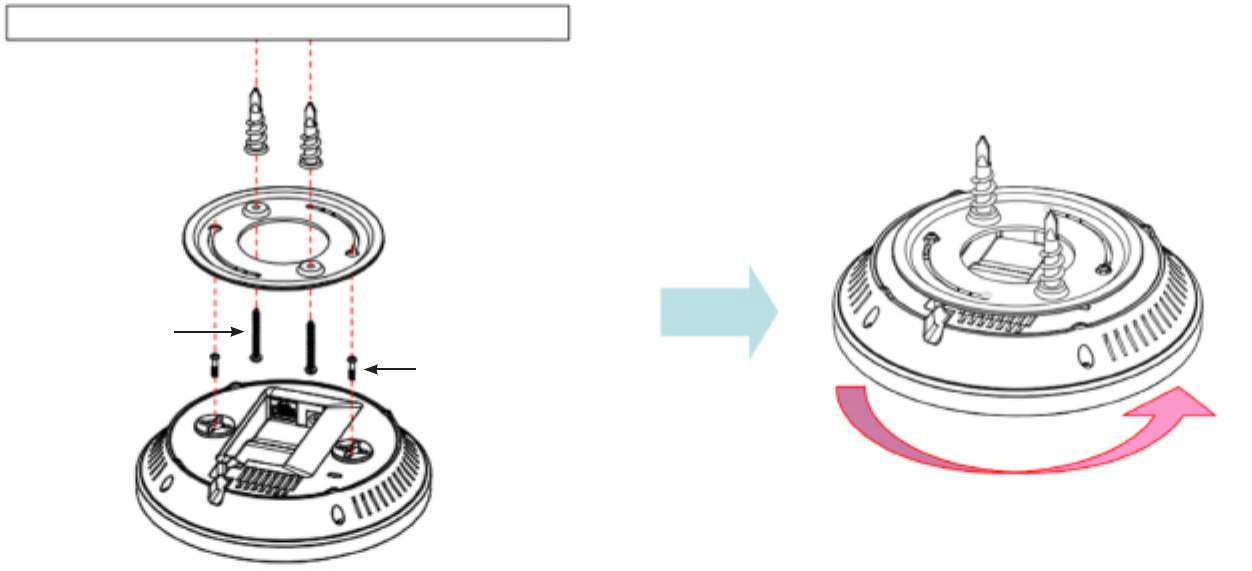
16
Using the provided hardware, the EAP1200H can be
attached to a ceiling or wall.
To attach the EAP1200H to a ceiling or wall
using the mounting bracket:
1. Attach the mounting bracket to the wall or ceiling using
the provided wall/ceiling mounting hardware kit.
2. Insert the provided short screws into the bottom cover
of the EAP1200H.
Leaveenoughofthescrewsexposedtoensurethatthe
unit can be attached to the mounting bracket.
Ifextraspaceisrequired,usetheprovidedspacersandlong
screws from the T-Rail mounting hardware kit to increase
the space between the unit and the mounting bracket.
3. Mount the EAP1200H on the mounting bracket by
rotating the unit clockwise about 90 degrees to secure it
in place.
Mounting the EAP1200H
Wall
Mounting Screw
Lock the EAP1200H by revolving
Mounting Bracket
P2.6*12 Screw
P3.5*32 Screw
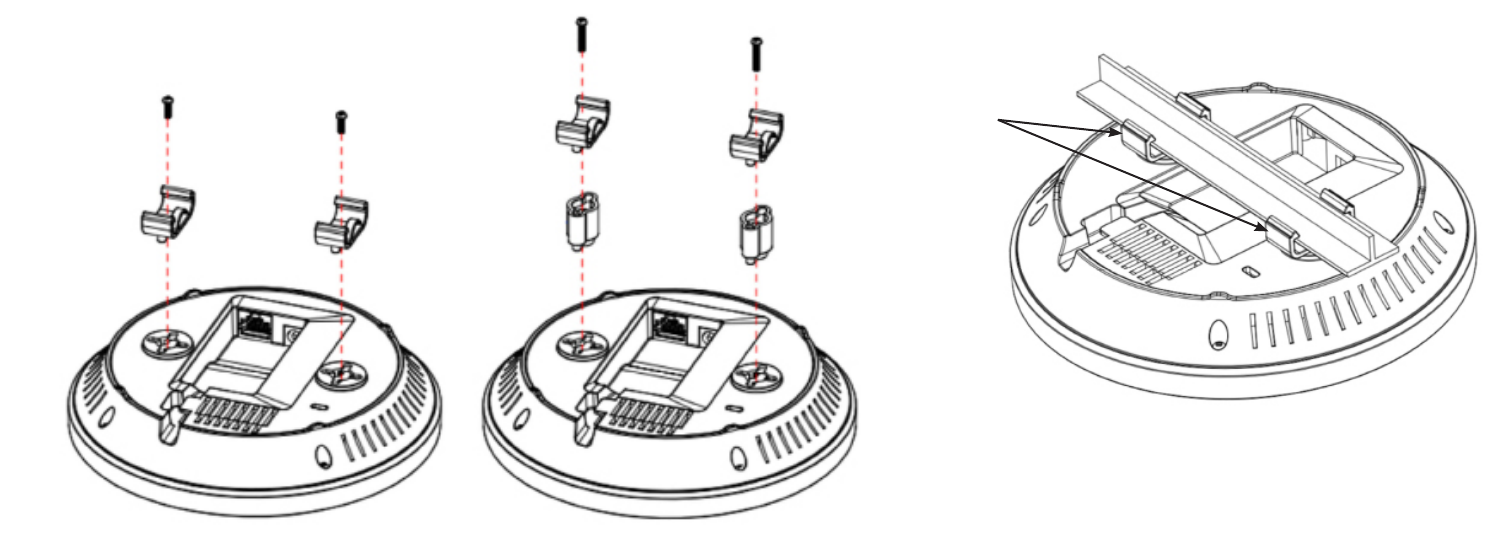
17
Attaching the EAP1200H to a ceiling using the
provided T-Rail connectors:
1. Attach the T-Rail connectors to the bottom cover of the
EAP1200H using the provided short screws.
Note: Two sizes of T-Rail connectors are included in the
mounting hardware kit: 15/16in (2.38cm) and 9/16in
(1.43cm).Ifextraspaceisrequiredtoaccommodatedrop
ceilingtiles,usetheprovidedspacersandlongscrews.
2. Line up the connected T-Rail connectors with an
appropriately sized rail and press the unit onto the rail
until it snaps into place.
Note: ToprotectyourEAP1200H,usetheKensington
Security Slot to attach a cable lock (cable lock is not
included).
P2.6*10 Screw
Clip
T-Rail
Clip Clips
Spacer
P2.6*25 Screw
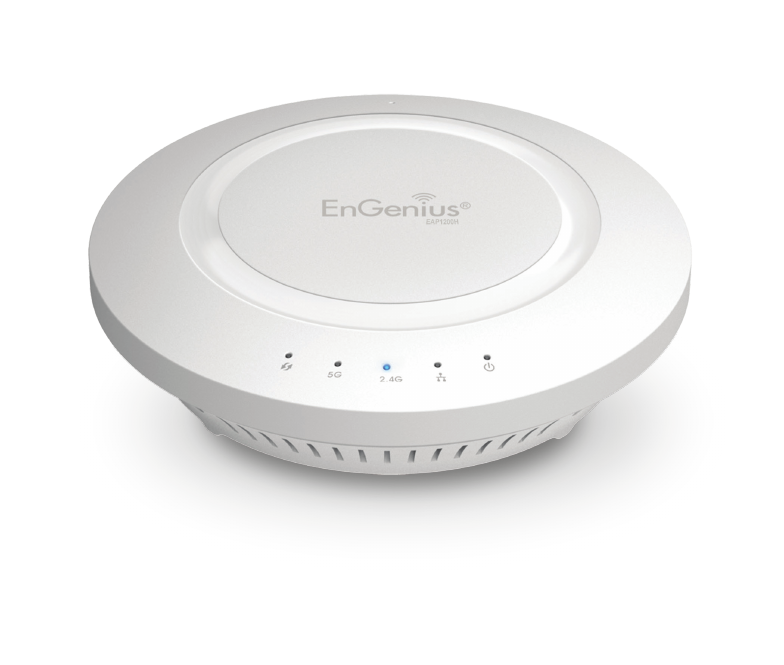
18
Chapter 3
Conguring Your Access Point
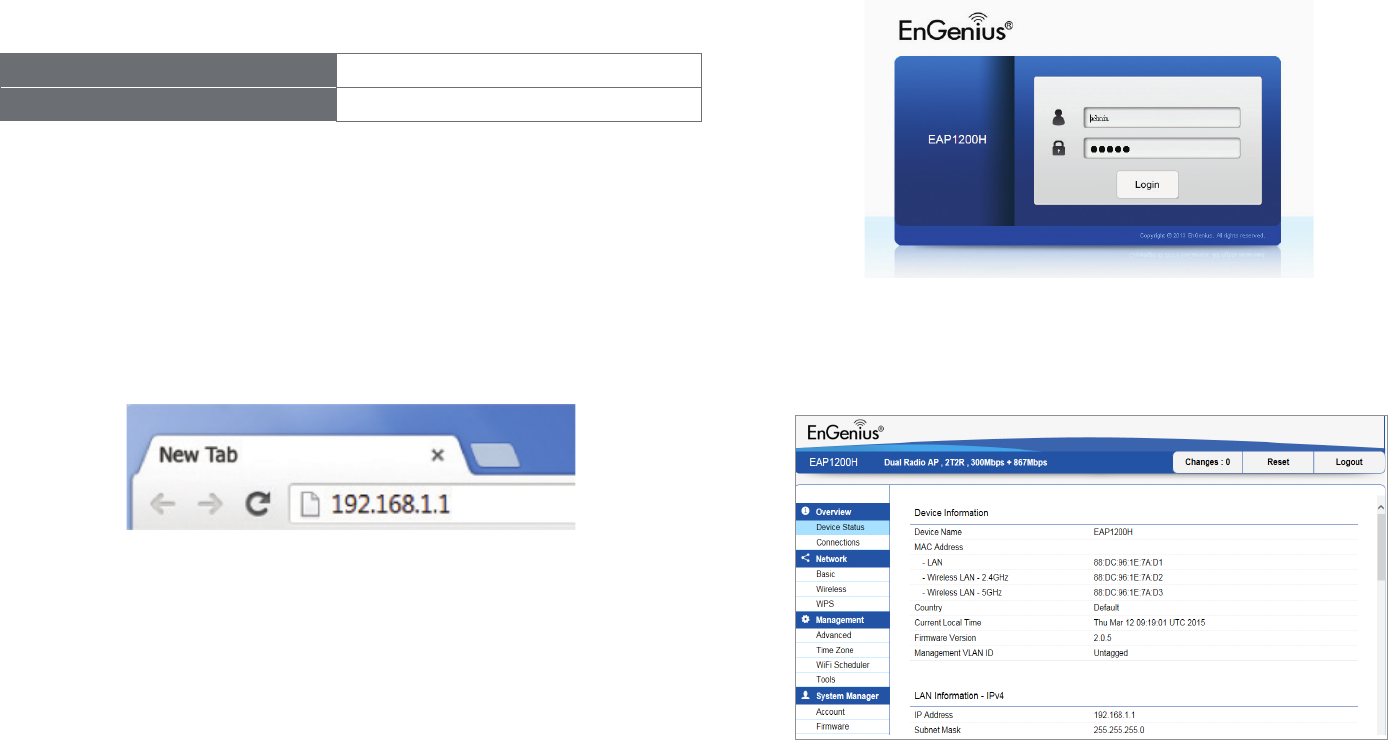
19
This section will show you how to congure the device
usingtheweb-basedcongurationinterface.
Default Settings
Please use your Ethernet port or wireless network adapter to
connect the Access Point.
IP Address 192.168.1.1
Username/Password admin/admin
Web Conguration
1. Openawebbrowser(InternetExplorer/Firefox/Safari)
and enter the IP Address http://192.168.1.1.
Note: If you have changed the default LAN IP Address of
theAccessPoint,ensureyouenterthecorrectIPAddress.
2. Thedefaultusernameandpasswordare:admin. Once
youhaveenteredthecorrectusernameandpassword,
click the Login button to open the web-based
congurationpage.
3. If successful, you will be logged in and see the
EAP1200H User Menu.
Conguring Your Access Point
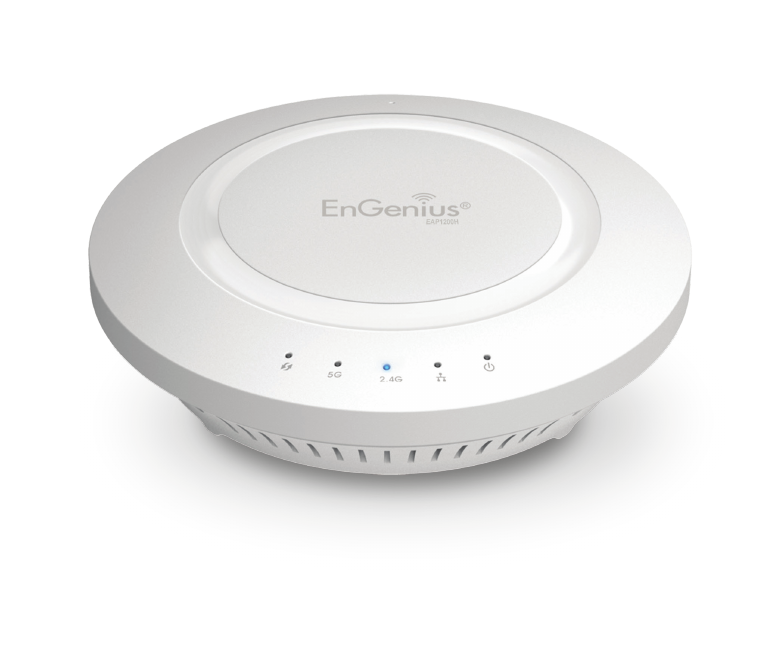
20
Chapter 4
Building a Wireless Network
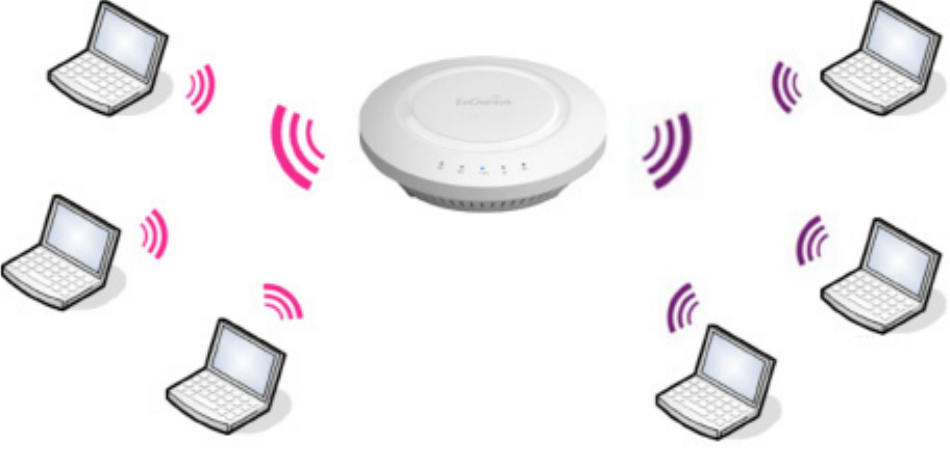
21
The EAP1200H has the ability to operate in various modes. This chapter describes the operating modes of the EAP1200H.
Access Point Mode
InAccessPointMode,theEAP1200HbehaveslikeacentralconnectionforstationsorclientsthatsupportIEEE802.11ac/a/b/
g/nnetworks.ThestationsandclientsmustbeconguredtousethesameSSID(ServiceSetIdentier)andsecuritypassword
toassociatewiththeEAP1200H.TheEAP1200Hsupportsuptoeight(8)SSIDsperband(16total)atthesametimeforsecure
access.
EAP1200H
AP/AP
Client
Client
Client Client
Client
Client
2.4 GHz 5 GHz

22
WDS AP Mode
The EAP1200H also supports WDS AP mode. This operating mode allows wireless connections to the EAP1200H using
WDStechnology.Inthismode,conguretheMACaddressesinbothAccessPointstoenlargethewirelessareabyenabling
WDS Link settings. WDS supports up to four (4) AP MAC addresses.
EAP1200H
WDS AP
EAP1200H
WDS AP
2.4 GHz 2.4 GHz
5 GHz 5 GHz
Client
Client Client
Client
Client
Computer
Client
Computer
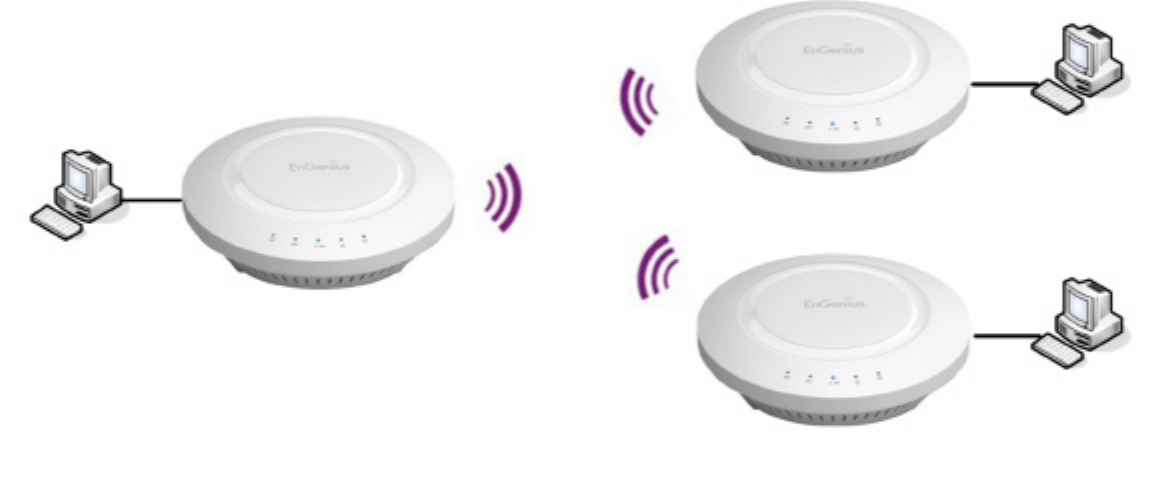
23
WDS Bridge Mode
InWDSBridgeMode,theEAP1200HcanwirelesslyconnectdifferentLANsbyconguringtheMACaddressandsecurity
settings of each EAP1200H device. Use this mode when two wired LANs located a small distance apart want to communicate
witheachother.ThebestsolutionistousetheEAP1200HtowirelesslyconnecttwowiredLANs,asshowninthefollowing
gure.
WDSBridgeModecanestablishuptofour(4)WDSlinks,creatingastar-likenetwork.
Note: WDS Bridge Mode does not act as an Access Point because Access Points linked by WDS use the same frequency
channel.MoreAccessPointsconnectedtogethermaylowerthroughput.Thiscongurationcanalsobesusceptible
togenerateendlessnetworkloopsinyournetwork,soitisrecommendedtoenabletheSpanningTreefunctionto
preventthisfromhappening.YoucanndinformationabouttheSpanningTreeFunctiononpage31.
EAP1200H
WDS Bridge
EAP1200H
WDS Bridge
EAP1200H
WDS Bridge
Client
Computer
Client
Computer
Client
Computer

24
Chapter 5
Overview
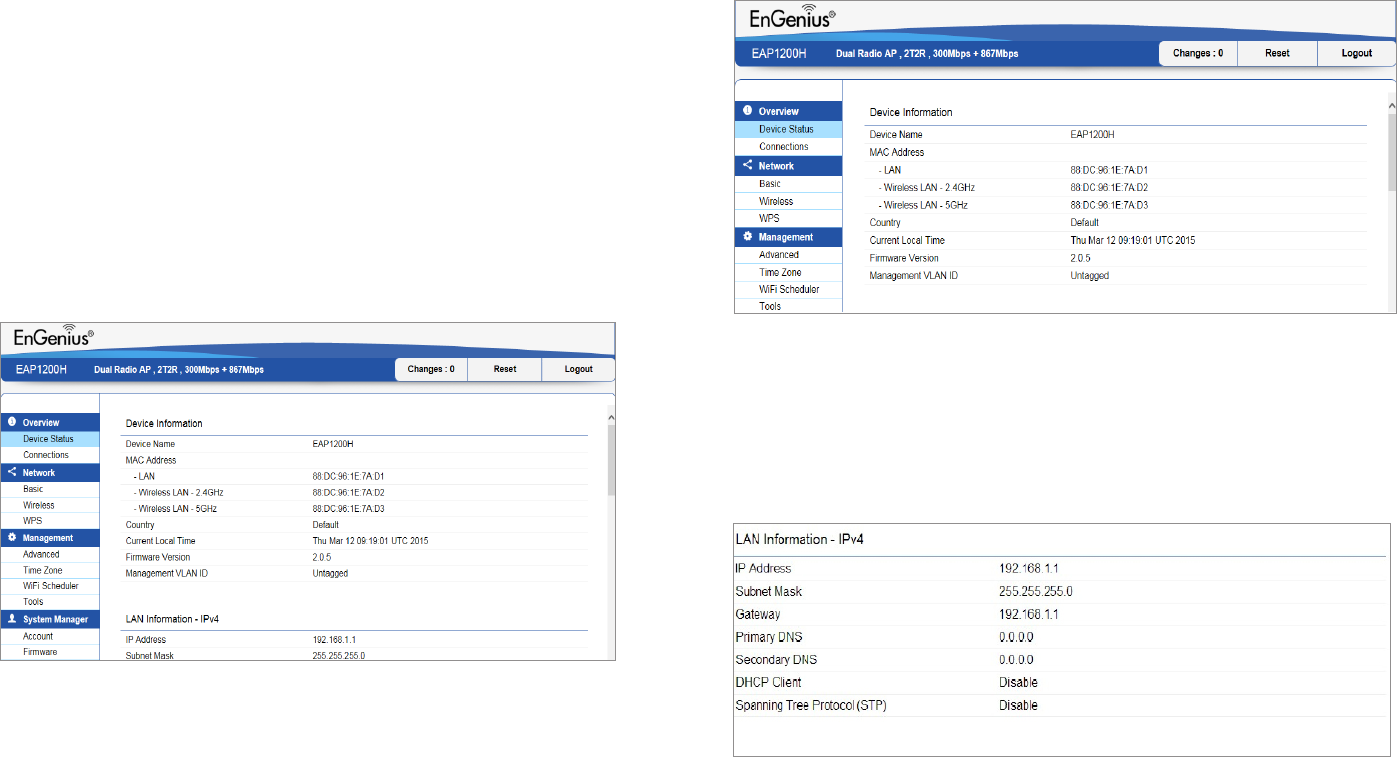
25
Overview
The Overviewsectioncontainsthefollowingoptions:
• DeviceStatus
• Connections
Thefollowingsectionsdescribetheseoptions:
Device Status
Clicking the Device Status link under the Overview menu
shows the status information about the current operating
mode.
• The Device Status section shows general system
informationsuchasDeviceName,MACaddress,Current
Time,FirmwareVersion,andManagementVLANID
Note: VLAN ID is only applicable in Access Point or WDS
AP mode.
• The LAN Information section under the Connections
link shows the Local Area Network settings such as the
LANIPAddress,Subnetmask,Gateway,DNSAddress,
DHCPClient,andSTPstatus.
• TheCurrent 2.4 GHz/5 GHz Wireless Settings section
under the Basic link shows wireless information such
asOperatingMode,Frequency,andChannel.Sincethe
EAP1200Hsupportsmultiple-SSIDs,informationabout
each SSID and security settings are displayed.
Note: ProleSettingsisonlyapplicableinAccessPoint
or WDS AP mode.
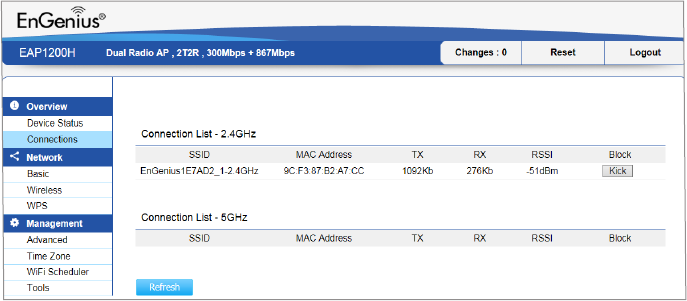
26
Connections
The EAP1200H automatically logs (records) events of
possible interest in its internal memory. To view the
logged information, click the Connections link under
the Device Status menu. If there is not enough internal
memorytologallevents,oldereventsaredeletedfrom
thelog.Whenpowereddownorrebooted,thelogwillbe
cleared.
Click Refresh to refresh the Connections List page.
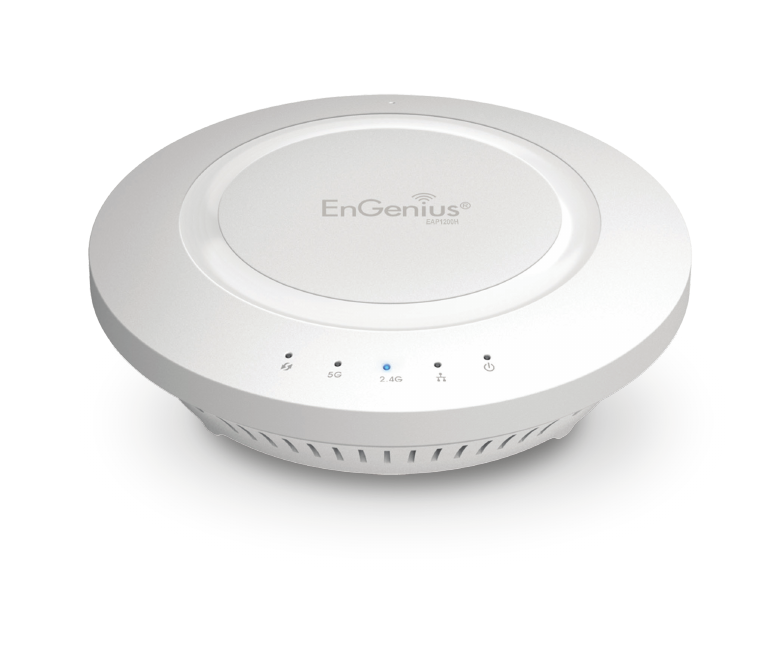
27
Chapter 6
Network
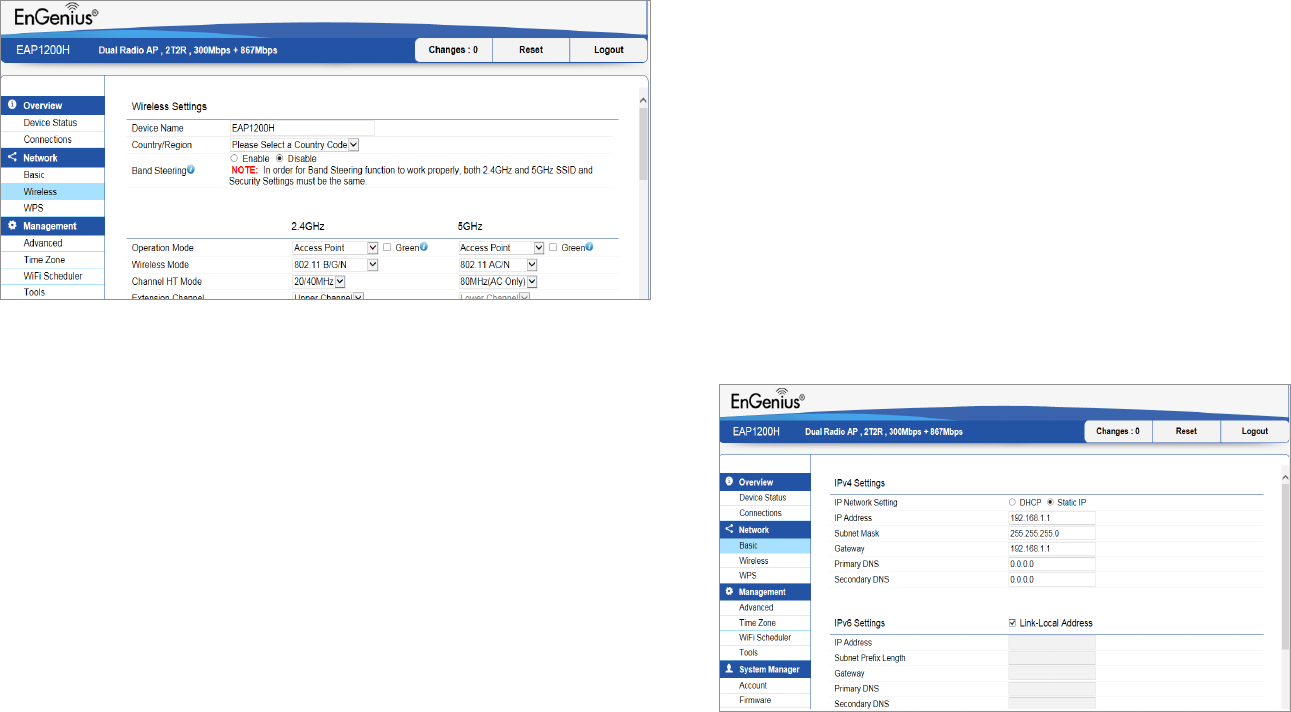
28
Operation Modes
TheEAP1200Hsupportsthreeoperatingmodes:
AccessPoint,WDSAP,andWDSBridge.
Device Settings
Toaccessoperationmode,clicktheWireless section under
Network in the sidebar. You will see wireless settings
customizable options for both the 2.4 GHz and 5 GHz
modes.UnderWirelesssettings,youwillsee:
Device Name: Enter a name for the device. The name you
type appears in SNMP management. This name is not the
SSID and is not broadcast to other devices.
Country/Region: Select a Country/Region to conform to
local regulations.
Operation Mode: Use the radio button to select an
operating mode.
Band Steering:EnableBandSteeringtosends802.11n
clients to the 5 GHz band, where 802.11b/g clients
cannotgo,andleavesthe802.11b/gclientsin2.4GHzto
operate at their slower rates. Band Steering works within
the Access Point by directing 5 GHz-capable clients to
that band.
*Note:InorderfortheBandSteeringfunctiontowork
properly,boththe2.4Ghzandthe5GHzSSIDandsecurity
settings must be under the same selection settings.
Basic
This page allows you to modify the device’s IP settings.

29
IP Network Settings
Select whether the device IP address will use the static
IPaddressspeciedintheIPAddresseldorbeobtained
automatically when the device connects to a DHCP server.
IP Address: The IP Address of this device.
IP Subnet Mask: The IP Subnet mask of this device.
Gateway: The Default Gateway of this device. Leave it
blank if you are unsure of this setting.
Primary/Secondary DNS: The primary/secondary DNS
address for this device.
Click Savetoconrmthechanges.
Spanning Tree Settings
This page allows you to modify the Spanning Tree settings.
Enabling Spanning Tree protocol will prevent network loops
in your LAN network.
Spanning Tree Status:Enables ordisables theSpanning
Tree function.
Hello Time: Specify Bridge Hello Time, in seconds. This
value determines how often the device sends handshake
packets to communicate information about the topology
throughout the entire Bridged Local Area Network.
Max Age: SpecifyBridgeMaxAge,inseconds.Ifanother
bridge in the spanning tree does not send a hello packet for
alongperiodoftime,itisassumedtobeinactive.
30
Forward Delay:SpecifesBridgeForwardDelay,inseconds.
Forwarding Delay Time is the time spent in each of the
Listening and Learning states before the Forwarding state
is entered. This delay is provided so that when a new bridge
comesontoabusynetwork,itanalyzesdatatrafcbefore
participating.
Priority: Specify the Priority Number. A smaller number has
greater priority.
Save: Click Savetoconrmthechanges.
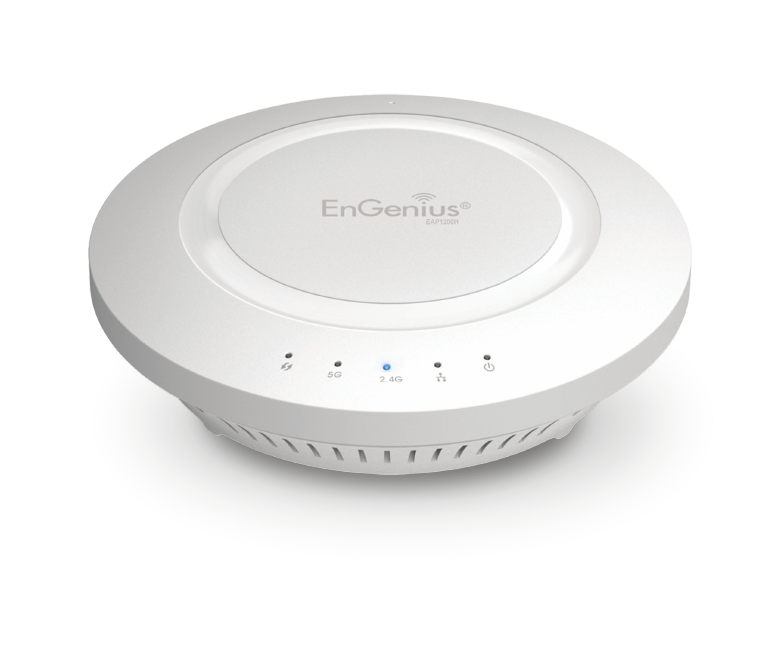
31
Chapter 7
2.4GHz & 5GHz Wireless
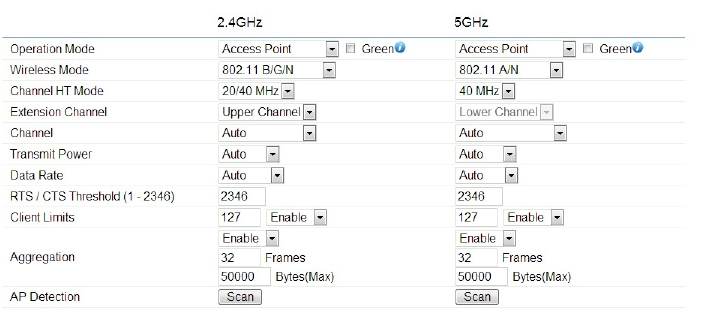
32
This page displays the current status of the Wireless
settings of the EAP1200H.
Access Point/WDS AP mode:
Wireless Mode: Supports 802.11b/g/n mixed mode in
2.4GHzand802.11ac/a/nmixedmodein5GHz.
Channel HT Mode: The default channel bandwidth is
20/40/80MHz. The larger the channel, the better the
transmission quality and speed.
Extension Channel: Select Upper or Lower channel. Your
selection may affect the Auto Channel function.
Channel/Frequency: Select the channel and frequency
appropriate for your country’s regulation.
Auto: Check this option to the enable the Auto-Channel
feature.
RTS/CTS Threshold:Speciesthethresholdpackagesize
for RTC/CTS. A small number causes RTS/CTS packets to be
sent more often and consumes more bandwidth.
Client Limits: Limits the total number of clients.
Aggregation: Merges data packets into one packet. This
optionreducesthenumberofpackets,butalsoincreases
packet sizes.
AP Detection: AP Detection can select the best channel to
use by scanning nearby areas for Access Points.
Current Prole: You can congure up to eight different
SSIDs (4 in WDS AP mode). If multiple client devices will be
accessingthenetwork, you can arrangethedevicesinto
SSID groups. Click Edittoconguretheproleandcheck
whetheryouwishtoenableextraSSIDs.
Save: Click Savetoconrmthechanges.
Wireless Network
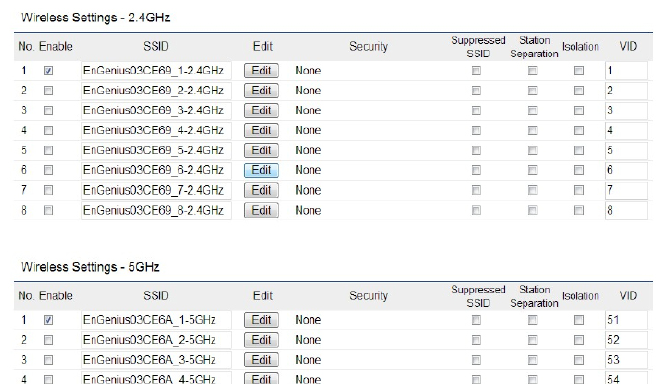
33
2.4GHz/5 GHz SSID Prole
Under Wireless Settings,youcanedittheSSIDproleto
tyourneeds.ClickEdit under the SSID you would like to
make changes to.
SSID:SpeciestheSSIDforthecurrentprole.
Suppressed SSID: Check this option to hide the SSID from
clients.Ifchecked,theSSIDwillnotappearinthesitesurvey.
Station Separation: Click the appropriate button to allow
or prevent communication between client devices.
Wireless Security: See the Wireless Security section on
page 36.
Isolation:ChecktheboxtoEnable or Disable the Isolation
feature.
Save: Click Save to accept the changes.
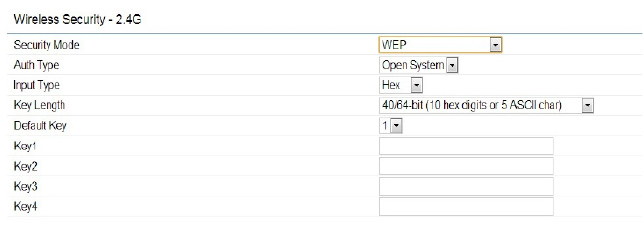
34
The Wireless Security section lets you congure the
EAP1200H’ssecuritymodes:
WEP
WPA-PSK
WPA2-PSK
WPA-PSKMixed
WPA-Enterprise
WPA2-Enterprise
WPAMixedEnterprise.
It is strongly recommended that you use WPA2-PSK. Click
on the EditbuttonunderWirelessSettingsnexttotheSSID
to change the security settings.
WEP Encryption:
Auth Type: Select Open System or Shared Key.
Input Type:ASCII:RegularText(Recommended)
HEX: HexadecimalNumbers(Foradvancedusers)
Key Length: Select the desired option and ensure the
wirelessclientsusethesamesetting.Yourchoicesare:64,
128,and152-bitpasswordlengths.
Default Key: Select the key you wish to be default.
Transmitted data is ALWAYS encrypted using the Default
Key; the other Keys are for decryption only. You must enter
a Key Value for the Default Key.
Wireless Security

35
Encryption Key: Enter the Key Value or values you wish to
use. The default is none.
WPA-PSK (WPA Pre-Shared Key) Encryption:
Encryption:SelecttheWPAencryptiontypeyouwouldlike
to use. Please ensure that your wireless clients use the
same settings.
Passphrase: Wireless clients must use the same Key to
associatethedevice.IfusingASCIIformat,theKeymust
befrom8to63charactersinlength.IfusingHEXformat,
theKeymustbe64HEXcharactersinlength.
Group Key Update Interval: Specifyhowoften,inseconds,
the Group Key changes.
WPA2-PSK Encryption:
Encryption:SelecttheWPAencryptiontypeyouwould
like to use. Please ensure that your wireless clients use
the same settings.
Passphrase: Wireless clients must use the same Key to
associatethedevice.IfusingASCIIformat,theKeymust
befrom8to63charactersinlength.IfusingHEXformat,
theKeymustbe64HEXcharactersinlength.
Group Key Update Interval: Specify how often, in
seconds,theGroupKeychanges.

36
WPA-PSK Mixed Encryption:
Encryption:SelecttheWPAencryptiontypeyouwouldlike
to use. Please ensure that your wireless clients use the
same settings.
Passphrase: Wireless clients must use the same Key to
associatethedevice.IfusingASCIIformat,theKeymust
befrom8to63charactersinlength.IfusingHEXformat,
theKeymustbe64HEXcharactersinlength.
Group Key Update Interval: Specifyhowoften,inseconds,
the group key changes.
WPA-Enterprise Encryption:
Encryption: Select the WPA encryption type you would like.
Please ensure that your wireless clients use the same settings.
Group Key Update Interval: Specifyhowoften,inseconds,
the group key changes.
Radius Server: Enter the IP address of the Radius server.
Radius Port: Enter the port number used for connections
to the Radius server.
Radius Secret: Enter the secret required to connect to the
Radius server.
Radius Accounting: Enables or disables the accounting
feature.
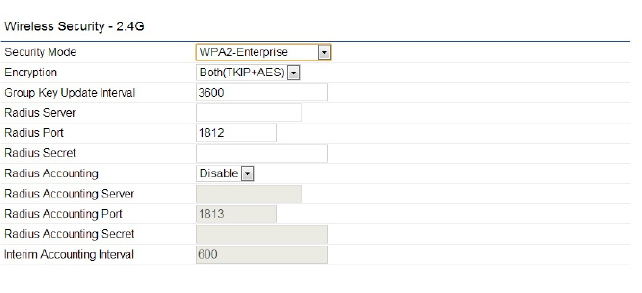
37
Radius Accounting Server: Enter the IP address of the
Radius accounting server.
Radius Accounting Port: Enter the port number used for
connections to the Radius accounting server.
Radius Accounting Secret: Enter the secret required to
connect to the Radius accounting server.
Interim Accounting Interval: Specify how often, in
seconds,theaccountingdatasends.
Note: 802.11n does not allow WEP/WPA-PSK TKIP/
WPA2-PSK TKIP security mode. The connection mode will
automaticallychangefrom802.11nto802.11g.
WPA2Enterprise Encryption:
Encryption: Select the WPA encryption type you would like.
Please ensure that your wireless clients use the same settings.
Group Key Update Interval: Specifyhowoften,inseconds,
the group key changes.
Radius Server: Enter the IP address of the Radius server.
Radius Port: Enter the port number used for connections
to the Radius server.
Radius Secret: Enter the secret required to connect to the
Radius server.
Radius Accounting: Enables or disables the Radius
accounting feature.
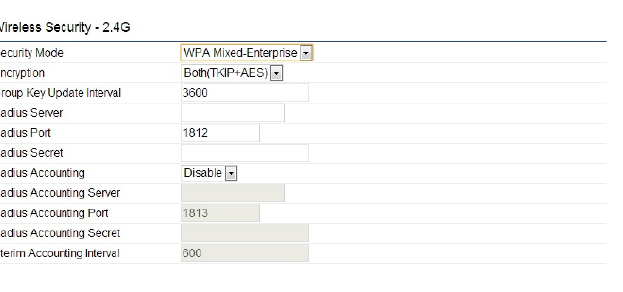
38
Radius Accounting Server: Enter the IP address of
the Radius accounting server.
Radius Accounting Port: Enter the port number used
for connections to the Radius accounting server.
Radius Accounting Secret: Enter the secret required
to connect to the Radius accounting server.
Interim Accounting Interval: Specify how often, in
seconds,theaccountingdatasends.
Note: 802.11n does not allow WEP/WPA-PSK TKIP/
WPA2-PSK TKIP security mode. The connection mode
willautomaticallychangefrom802.11nto802.11g.
WPA Mixed Enterprise Encryption:
Encryption: Select the WPA encryption type you would
like. Please ensure that your wireless clients use the
same settings.
Group Key Update Interval: Specify how often, in
seconds,thegroupkeychanges.
Radius Server: Enter the IP address of the Radius
server.
Radius Port: Enter the port number used for
connections to the Radius server.
Radius Secret: Enter the secret required to connect
to the Radius server.
Radius Accounting: Enables or disables the Radius
accounting feature.
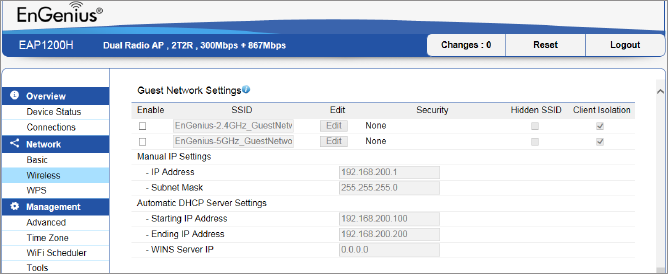
39
Radius Accounting Server: Enter the IP address of
the Radius accounting server.
Radius Accounting Port: Enter the port number used
for connections to the Radius accounting server.
Radius Accounting Secret: Enter the secret required
to connect to the Radius accounting server.
Interim Accounting Interval:Specifyhowoften,in
seconds,theaccountingdatasends.
Note: 802.11ndoesnotallowWEP/WPA-PSKTKIP/
WPA2-PSK TKIP security mode. The connection
mode will automatically change from 802.11n to
802.11g.
Guest Network Settings
Adding a guest network to allow visitors to use the
internet without giving out your ofce or company
wireless security. You can add a guest network to each
wireless network in the 2.4GHz frequencies and 5GHz
frequencies.
SSID:SpeciedtheSSIDforthecurrentprole.
Hidden SSID: Check this option to hide SSID from
clients,Ifchecked,thisSSIDwillnotappearintheAP
detect.
Client Isolation: Click the appropriate radio button
to allow or prevent communication between client
devices.
IP address: The IP Address of this device.
SubnetMask:TheIPSubnetmaskofthisdevice.
Starting IP Address: TherstIPAddressintherange
of the addresses by the DHCP server.
Ending IP Address: The last IP Address in the range of
addresses assigned by the DHCP server.

40
Fast Handover
Enable the Fast Handover feature by ensuring that
each client is served by at least one Access Point at
any time. Access Points continuously monitor the
connectivity quality of any client in their range and
efciently share this information with other Access
Points in the vincinity of that client to coordinate
which of them should serve the client best.
RSSI:EntertheRSSI(ReceivedSignalStrengthIndex)
in order to determine the handover procedure which
the current wireless link will terminate. RSSI is an
indication of the power level being received by the
antenna.Therefore,thehighertheRSSInumber,the
stronger the signal.
Fast Roaming
Enable the function to serve mobile client devices
that roam from access point to access point. Some
applications roam on client devices require fast re-
association when they roam to a different access
point.
Please enter the settings of the SSID and initialize
the Security mode to WPA-Mixed, WPA2 enterprise,
WPA2-PSK,WPA-MixedEnterpriseaswellastosetthe
RADIUSserverrstly.UsercanenableFastRoaming.
Please also set the same encryption under the same
SSID on other access point and enable Fast Roaming.
When the conguration is activated on different
access point, the mobile client devices can run the
voice service and require seamless roaming to prevent
delay in conversation from access point to access
point.

41
Wireless MAC Filtering is used to allow or deny network
access to wireless clients (computers, tablet PCs, NAS,
smartphones,etc.)accordingtotheirMACaddresses.You
can manually add a MAC address to restrict permission to
accessEAP1200H.Thedefaultsettingis:Disable Wireless
MAC Filter.
Note: Only applicable in Access Point and WDS AP mode.
ACL (Access Control List) Mode: Determines whether
network access is granted or denied to clients whose MAC
addresses appear in the MAC address table on this page.
Choicesgivenare:Disabled,DenyMACinthelist,orAllow
MAC in the list.
MAC Address: Enter the MAC address of the wireless client.
Add: Click Add to add the MAC address to the MAC Address
table.
Delete: Deletes the selected entries.
Save: Click Save to apply the changes.
Wireless MAC Filtering

42
This page allows you to congure wireless advanced
settings. It is recommended that the default settings are
usedunlesstheuserhasexperiencewithmoreadvanced
networking features.
2.4 GHz/5 GHz Wireless Advanced
Data Rate: Select a data rate from the drop-down list. The
data rate affects throughput of data in the EAP1200H.
Thelowerthedatarate,thelowerthethroughput,though
transmission distance will be lowered as well.
Transmit Power: Set the power output of the wireless
signal.
RTS/CTS Threshold: Specify the threshold package size
for RTC/CTS. A smaller number causes RTS/CTS packets to
be sent more often and in turn consumes more bandwidth.
Distance: Specify the distance between Access Points and
clients. Longer distances may drop high-speed connections.
Aggregation: Merges data packets into one packet. This
optionreducesthenumberofpackets,butincreasespacket
sizes.
Save: Click Savetoconrmthechanges.
Wireless Advanced
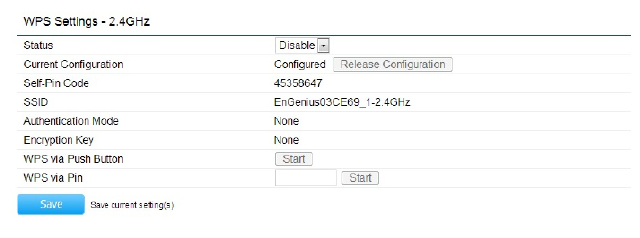
43
The Wi-Fi Protected Setup (WPS) feature complies with the
Wi-Fi Alliance WPS standard and makes it easier to quickly
addclientdevicestoanestablished,security-enabledWi-Fi
network.
WPSreducestheuserstepsrequiredtocongureanetwork
and supports two methods that are familiar to most
consumerstocongureanetworkandenablesecurity.
Note: Only applicable in Access Point and WDS AP
mode.
WPS (Wi-Fi Protected Setup)
WPS: Select to Enable or Disable the WPS feature.
WPS Current Status: Shows whether the WPS function is
Congured or Uncongured. When it is congured, the
WPS has been used to authorize a connection between the
device and wireless clients.
Self Pin Code: The PIN code of this device.
SSID: The SSID (wireless network name) used when
connecting using WPS.
Authentication Mode: Shows the encryption method used
by the WPS process.
Passphrase Key: This is the passphrase key that is randomly
generated during the WPS process. It is required if wireless
clients that do not support WPS attempt to connect to the
wireless network.
WPS via Push Button: Click this button to initialize the
WPS feature using the Push Button method.
WPS via PIN: Enter the PIN code of the wireless device
and click this button to initialize WPS feature using the PIN
method.
Save:ClickSavetoconrmthechanges.
WPS (Wi-Fi Protected Setup)

44
Using WDS (Wireless Distribution System) will allow
a network administrator or installer to connect to
Access Points wirelessly. Doing so will extend the wired
infrastructure to locations where cabling is not possible or
inefcienttoimplement.
Note: Compatibility between different brands and
models of Access Points is not guaranteed. It is
recommended that the WDS network be created using
thesamemodelsformaximumcompatibility.
Also Note: All Access Points in the WDS network must
use the same Channel and Security settings.
TocreateaWDSnetwork,pleaseentertheMACaddresses
of the Access Points that you want included in the WDS.
TherecanbeamaximumoffourAccessPoints.
Note: Only applicable in WDS AP and WDS Bridge modes.
2.4 GHz/5 GHz WDS Link Settings
Security: Select None or AES from the drop-down list.
AES Passphrase: Enter the Key Values you wish to use.
Other AP(s) must use the same key to establish WDS link.
MAC Address: Enter the Access Point’s MAC address to
whichyouwanttoextendthewirelessarea.
Mode:SelectDisable or Enable from the drop-down list.
Save: Click Savetoconrmthechanges.
WDS Link Settings
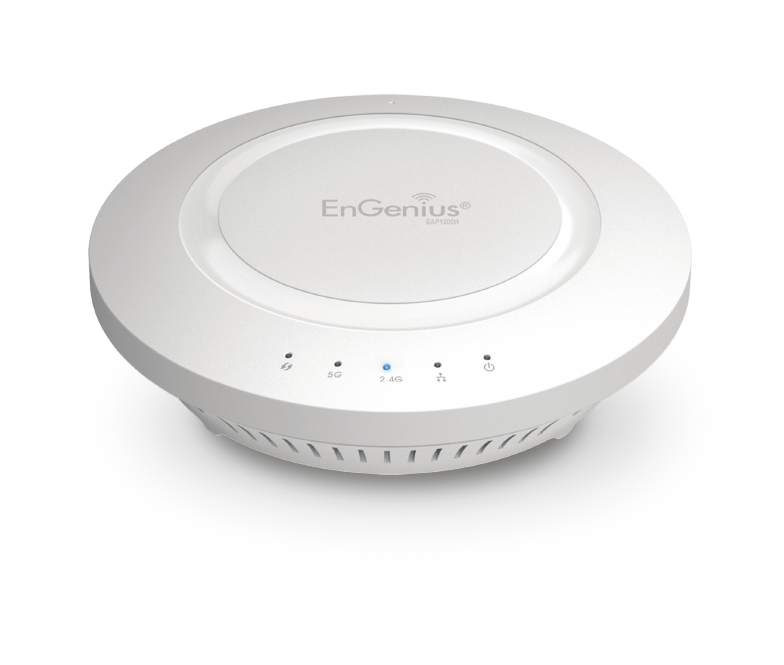
45
Chapter8
Management

46
This page allows you to change the EAP1200H username
andpassword.Bydefault,theusernameisadmin and the
password is admin. The password can contain from 0 to 12
alphanumeric characters and is case sensitive.
Username:admin
Password:admin
Account Setting
New Name: Enter a new username for logging in to the
NewNameentrybox.
Old Password: Enter the old password for logging in to the
OldPasswordentrybox.
New Password: Enter the new password for logging in to
theNewPasswordentrybox.
Conrm Password: Re-enter the new password in the
ConrmPasswordentryboxforconrmation.
Apply: Click Apply to save the changes.
Note: it is highly reccomended that you change you
password to something more unique for greater security.
Administration
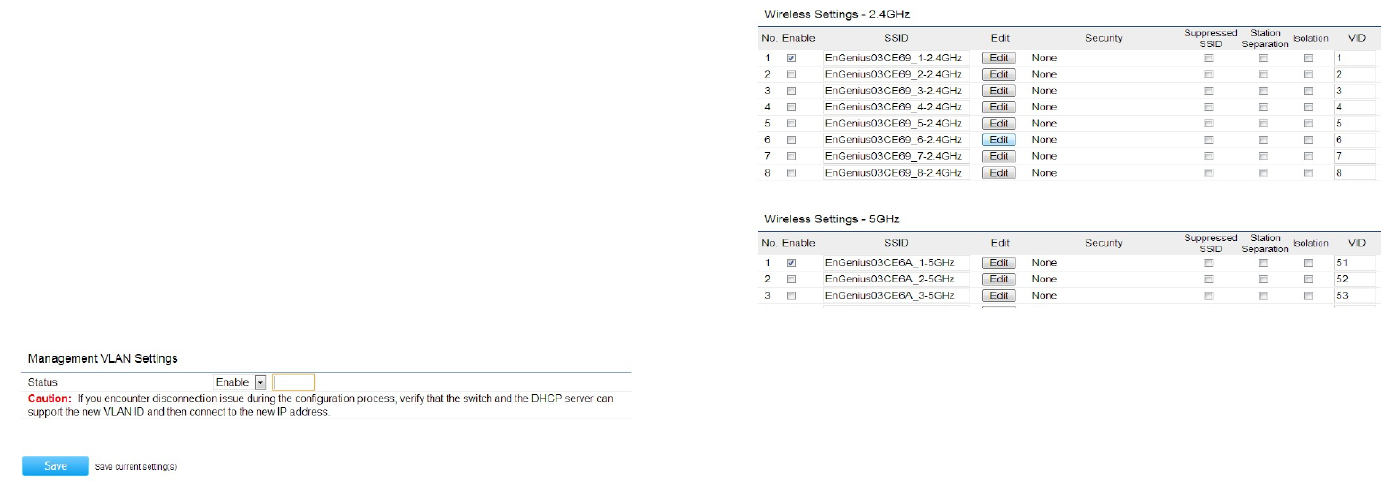
47
Management VLAN Settings
This page allows you to assign a VLAN tag to the packets. A
VLAN is a group of computers on a network whose software
hasbeenconguredsothattheybehaveasiftheywereon
a separate Local Area Network (LAN). Computers on VLAN
donothavetobephysicallylocatednexttooneanother
on the LAN.
TocongureVLANtags,youmustrstIsolateandenter
a VID before enabling VLAN under Management VLAN ID.
Note: Only applicable in Access Point and WDS AP mode.
Prole Isolation:Restrictclientsfromcommunicatingwith
differentVIDsbycheckingtheIsolationboxfortheSSID
you wish to select under the Wireless Settings funtion.
VLAN ID (VID): SpeciestheVLANtagforeachprole.
Management VLAN ID: If your network includes VLANs,
you can specify a VLAN ID for packets pass through the
AccessPointwithatag.Otherwise,selectnoVLANtag.
Save: Click Savetoconrmthechanges.
Note:
1.IfyoureconguretheManagementVLANID,youmay
lose your connection to the EAP1200H. Verify that the
DHCPserversupportsthereconguredVLANID,then
reconnect to the EAP1200H using the new IP address.

48
Wireless Trafc Shaping
Trafc Shaping regulates the ow of packets leaving an
interface to deliver improved Quality of Service. To edit
WirelessTrafcShaping,clickEdit for the SSID you would
liketocongureunderWirelessSettings.
Enable Trafc Shaping:selectthisoptionfromthedrop-
downboxtoenableWirelessTrafcShaping.
Download Limit: Speciesthewirelesstransmissionspeed
used for downloading.
Upload Limit: Species the wireless transmission speed
used for uploading.
Save: Click Savetoconrmthechanges.
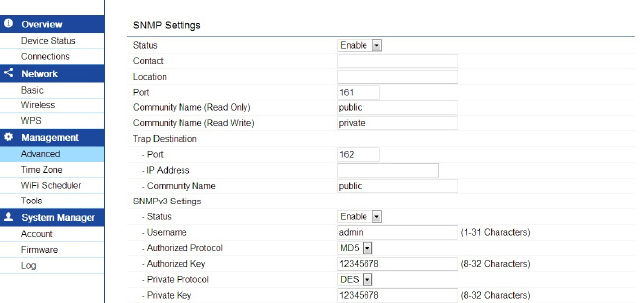
49
SNMP Settings
ThispageallowsyoutoassigntheContactDetails,Location,
Community Name, and Trap Settings for Simple Network
Management Protocol (SNMP). This is a networking
management protocol used to monitor network attached
devices. SNMP allows messages (called protocol data units) to
be sent to various parts of the network. Upon receiving these
messages,SNMPcompatibledevices(calledagents)returns
the data stored in their Management Information Bases. To
congureSNMPSettings,clickundertheAdvanced tab on
the side bar under Management.
Status:EnablesorDisablestheSNMPfeature.
Contact: Speciesthecontactdetailsofthedevice.
Location: Speciesthelocationofthedevice.
Port:Displaystheportnumber.
Community Name (Read Only): Species the password
for the SNMP community for read only access.
Community Name (Read/Write):Speciesthe password
for the SNMP community with read/write access.
Trap Destination Address: Species the port and IP
address of the computer that will receive the SNMP traps.
Trap Destination Community Name: Species the
password for the SNMP trap community.
SNMPv3 Status: Enables or Disables the SNMPv3 feature.
User Name: Species the username for the SNMPv3.
feature
Auth Protocol: Select the Authentication Protocol type:
MDS or SHA.
Auth Key: Specify the Authentication Key for authentication.
50
Priv Protocol:SelectthePrivacyProtocoltype:DES.
Priv Key: Speciestheprivacykeyforprivacy.
Engine ID: SpeciestheEngineIDforSNMPv3.
Save: Click Save to apply the changes.

51
Backup/Restore
This page allows you to save the current device
configurations. When you save the configurations,
you can also reload the saved configurations into the
device through the Restore Saved Settings from a file
folder.Ifextremeproblemsoccur,orifyouhavesetthe
EAP1200Hincorrectly,youcanusetheFactoryDefault
button in the Revert to Factory Default Settings section
to restore all the configurations of the EAP1200H to
the original default settings. To Configure the Backup/
Restore Settings, click Firmware under the Systems
Manager tab.
Factory Settings
Backup Settings: To restore settings that have been
previouslybackedup,clickExport,selectthefile,and
click Restore.
Restore New Setting:Choosethefileyouwishrestore
for settings and click Import.
Reset to Default: Click the Reset button to restore the
EAP1200H to its factory default settings.
User Settings
Back Up Setting as Default: Click Backup to backup the
user settings you would like to use as the default settings.
Restore to User Default: Click Restore to restore user
settings to the factory standard settings.

52
Auto Reboot Settings
You can specify how often you would like to reboot
theEAP1200H.ToconfiguretheAutoRebootsettings,
click the Wi-Fi Scheduler tab on the side bar under
Management.
Auto Reboot Setting: Enables or disables the Auto
Reboot function.
Frequency of Auto Reboot: Specifies the time and
frequency in rebooting the EAP1200H by Min, Hour,
Day and/or Week.
Click Save to apply the changes.

53
Firmware Upgrade
This page allows you to upgrade the Firmware of the
EAP1200H.
To Perform the Firmware Upgrade:
1. Click the Choose File button and navigate the OS File
SystemtothelocationoftheFirmwareupgradele.
2. Selecttheupgradele.Thenameofthelewillappear
intheUpgradeFileeld.
3. Click the Upload button to commence the Firmware
upgrade.
Note: The device is unavailable during the upgrade
process and must restart when the upgrade is completed.
Any connections to or through the device will be lost.
Date and Time Settings
This page allows you to set the internal clock of the
EAP1200H.ToaccesstheDateandTimesettings,click
Time Zone under the Management tab on the side bar.
Manually Set Date and Time: Manually specify the
date and time.
Synchronize with PC: Click to Synchronize the
EAP1200H with the computer’s internal clock.
Automatically Get Date and Time: Enter the IP address
of an NTP server or use the default NTP server to have
the internal clock set automatically.
Time Zone: Choose the time zone you would like to use
from the drop-down list.
Enable Daylight Savings:Checktheboxtoenableor
54
disabledaylightsavingstimefortherEAP1200H.Next,
enter the dates that correspond to the present year’s
daylight savings time.
Click Apply to save the changes.
would like to remote to.
Log Server IP Address: Enter the IP address of the log
server.
Apply: Click Apply to save the changes.

55
System Log
This page allows you to setup the System Log and local
log functions of the EAP1200H. Click Log under the
Systems Manager tab to open up the System Log page.
Status: Enables or disables the System Log function.
Log Type: Select the Log Type mode you would like to
use.
Remote Log: Enables or disables the Remote Log
feature.Ifenabled,entertheIPaddressoftheLogyou
Tools
This page allows you to analyze the connection quality
of the EAP1200H and trace the routing table to a target
in the network.

56
Ping Test Parameters
Target IP/Domain Name: Enter the IP address you
would like to search.
Ping Packet Size: Enter the packet size of each ping.
Number of Pings: Enter the number of times you wish
to ping.
Start Ping: Click Start Ping to begin pinging target
device (via IP).
Traceroute Parameters
Target IP/Domain Name: Enter an IP address or domain
name you wish to trace.
Start: Click Start to begin the trace route operation.
Stop: Halts the traceroute test.

57
Speed Test Parameters
Target IP/Domain Name: Enter an IP address or
domain name you wish to run a Speed Test for.
Time Period/Check Interval: Enter the time in
seconds that you would like the test to run for and in
how many intervals.
Start:StartstheSpeedTest.
LED Control
ThispageallowsyoutocontroltheLEDcontrolfunctions:
Power status, LAN interface, 2.4G/5G WLAN interface
and WPS.
Click Apply to save the settings after selecting your
choicesfromthedrop-downboxes.
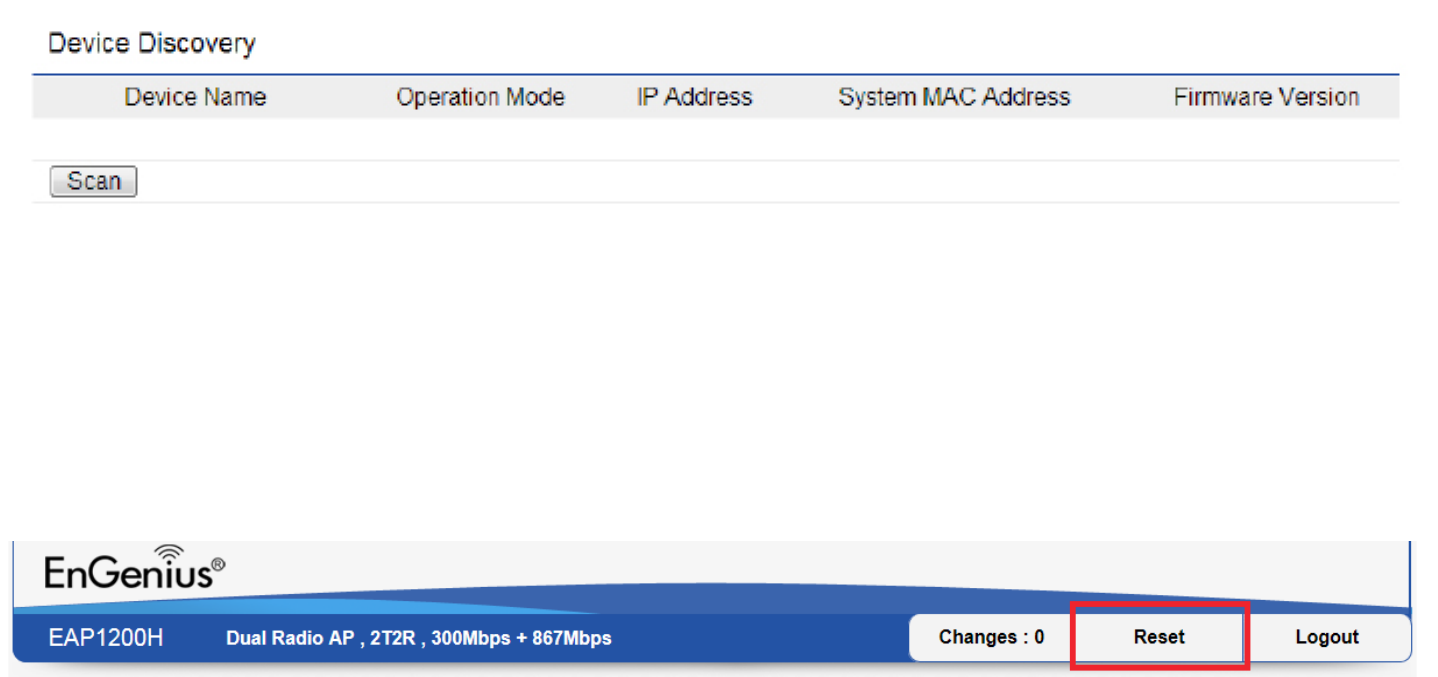
58
Device Discovery
UnderDeviceDiscovery,youcanchoosefortheEAP1200H
to Automatically scan for local devices to connect to. Click
Scan to begin the process.
Reset
Insomecircumstances,youmayberequiredtoforcethe
device to reboot. Click on Reboot the Device to reboot
the EAP1200H.
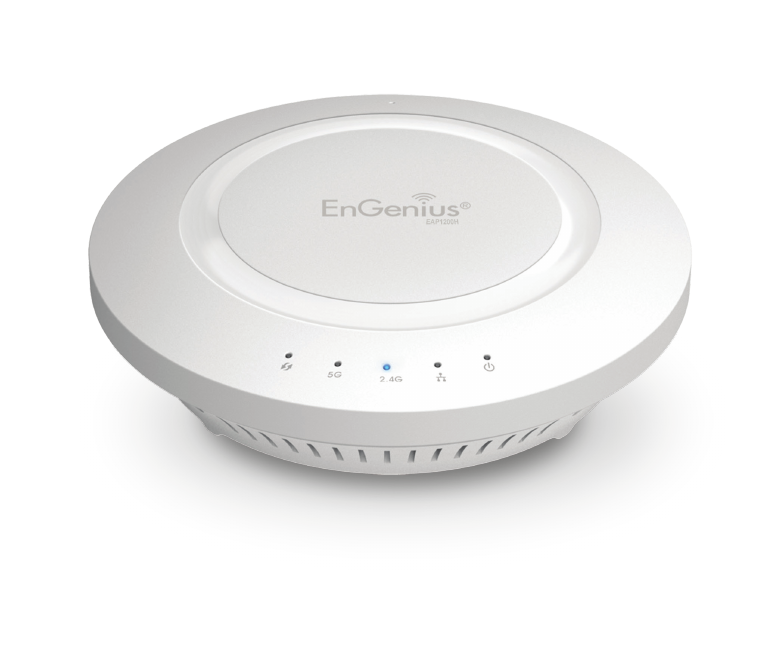
59
Appendix

60
Federal Communication Commission Interference Statement
This equipment has been tested and found to comply with the limits for a Class B digital device, pursuant to Part 15 of the FCC Rules. These limits are
designed to provide reasonable protection against harmful interference in a residential installation. This equipment generates, uses, and can radiate
radio frequency energy and, if not installed and used in accordance with the instructions, may cause harmful interference to radio communications.
However, there is no guarantee that interference will not occur in a particular installation. If this equipment does cause harmful interference to radio
or television reception, which can be determined by turning the equipment o and on, the user is encouraged to try to correct the interference by
one of the following measures:
• Reorientorrelocatethereceivingantenna.
• Increasetheseparationbetweentheequipmentandreceiver.
• Connecttheequipmentintoanoutletonacircuitdierentfromthattowhichthereceiverisconnected.
• Consultthedealeroranexperiencedradio/TVtechnicianforhelp.
FCC Caution:
Any changes or modications not expressly approved by the party responsible for compliance could void the user’s authority to operate
this equipment.
This device complies with Part 15 of the FCC Rules. Operation is subject to the following two conditions: (1) This device may not cause harmful
interference, and (2) this device must accept any interference received, including interference that may cause undesired operation.
This transmitter must not be co-located or operating in conjunction with any other antenna or transmitter. Operations in the 5.15-5.25 GHz band
are restricted to indoor usage only.
IMPORTANT NOTE:
Radiation Exposure Statement
This equipment complies with FCC radiation exposure limits set forth for an uncontrolled environment. This equipment should be installed and
operated with a minimum distance of 25 cm between the radiator & your body.
Appendix A
61
Europe – EU Declaration of Conformity
ThisdevicecomplieswiththeessentialrequirementsoftheR&TTEDirective1999/5/EC.Thefollowingtestmethodshavebeenappliedinorder
toprovepresumptionofconformitywiththeessentialrequirementsoftheR&TTEDirective1999/5/EC:
• EN60950-1
Safety of Information Technology Equipment
• EN50385
Generic standard to demonstrate the compliance of electronic and electrical apparatus with the basic restrictions related to human exposure
to electromagnetic elds (0 Hz - 300 GHz)
• EN300328
Electromagnetic compatibility and Radio spectrum Matters (ERM); Wideband Transmission systems; Data transmission equipment operating
in the 2,4 GHz ISM band and using spread spectrum modulation techniques; Harmonized EN covering essential requirements under article
3.2 of the R&TTE Directive
• EN301893
Broadband Radio Access Networks (BRAN); 5 GHz high performance RLAN; Harmonized EN covering essential requirements of article 3.2 of
the R&TTE Directive
• EN301489-1
Electromagnetic compatibility and Radio Spectrum Matters (ERM); ElectroMagnetic Compatibility (EMC) standard for radio equipment and
services; Part 1: Common technical requirements
• EN301489-17
Electromagnetic compatibility and Radio spectrum Matters (ERM); ElectroMagnetic Compatibility (EMC) standard for radio equipment and
services; Part 17: Specic conditions for 2,4 GHz wideband transmission systems and 5 GHz high performance RLAN equipment
Appendix B - CE Interference Statement

62
This device is a 5GHz wideband transmission system (transceiver), intended for use in all EU member states and EFTA countries, except in France
and Italy where restrictive use applies.
In Italy the end-user should apply for a license at the national spectrum authorities in order to obtain authorization to use the device for setting
upoutdoorradiolinksand/orforsupplyingpublicaccesstotelecommunicationsand/ornetworkservices.
This device may not be used for setting up outdoor radio links in France and in some areas the RF output power may be limited to 10 mW EIRP
in the frequency range of 2454 – 2483.5 MHz. For detailed information the end-user should contact the national spectrum authority in France.
Česky [Czech] [Jméno výrobce] tímto prohlašuje, že tento [typ zařízení] je ve shodě se základními požadavky a dalšími příslušnými
ustanoveními směrnice 1999/5/ES.
Dansk [Danish] Undertegnede [fabrikantens navn] erklærer herved, at følgende udstyr [udstyrets typebetegnelse] overholder de
væsentlige krav og øvrige relevante krav i direktiv 1999/5/EF.
Deutsch [German] Hiermit erklärt [Name des Herstellers], dass sich das Gerät [Gerätetyp] in Übereinstimmung mit den grundlegenden
Anforderungen und den übrigen einschlägigen Bestimmungen der Richtlinie 1999/5/EG bendet.
Eesti [Estonian] Käesolevaga kinnitab [tootja nimi = name of manufacturer] seadme [seadme tüüp = type of equipment] vastavust
direktiivi 1999/5/EÜ põhinõuetele ja nimetatud direktiivist tulenevatele teistele asjakohastele sätetele.
English Hereby, [name of manufacturer], declares that this [type of equipment] is in compliance with the essential requirements
and other relevant provisions of Directive 1999/5/EC.
Español [Spanish] Por medio de la presente [nombre del fabricante] declara que el [clase de equipo] cumple con los requisitos esenciales
y cualesquiera otras disposiciones aplicables o exigibles de la Directiva 1999/5/CE.
Ελληνική [Greek] ΜΕ ΤΗΝ ΠΑΡΟΥΣΑ [name of manufacturer] ΔΗΛΩΝΕΙ ΟΤΙ [type of equipment] ΣΥΜΜΟΡΦΩΝΕΤΑΙ ΠΡΟΣ ΤΙΣ ΟΥΣΙΩΔΕΙΣ
ΑΠΑΙΤΗΣΕΙΣ ΚΑΙ ΤΙΣ ΛΟΙΠΕΣ ΣΧΕΤΙΚΕΣ ΔΙΑΤΑΞΕΙΣ ΤΗΣ ΟΔΗΓΙΑΣ 1999/5/ΕΚ.

63
Français [French] Par la présente [nom du fabricant] déclare que l’appareil [type d’appareil] est conforme aux exigences essentielles et aux
autres dispositions pertinentes de la directive 1999/5/CE.
Italiano [Italian] Con la presente [nome del costruttore] dichiara che questo [tipo di apparecchio] è conforme ai requisiti essenziali ed alle
altre disposizioni pertinenti stabilite dalla direttiva 1999/5/CE.
Latviski [Latvian] Ar šo [name of manufacturer / izgatavotāja nosaukums] deklarē, ka [type of equipment / iekārtas tips] atbilst Direktīvas
1999/ 5/EK būtiskajām prasībām un citiem ar to saistītajiem noteikumiem.
Lietuvių [Lithuanian] Šiuo [manufacturer name] deklaruoja, kad šis [equipment type] atitinka esminius reikalavimus ir kitas 1999/5/EB
Direktyvos nuostatas.
Nederlands [Dutch] Hierbij verklaart [naam van de fabrikant] dat het toestel [type van toestel] in overeenstemming is met de essentiële eisen
en de andere relevante bepalingen van richtlijn 1999/5/EG.
Malti [Maltese] Hawnhekk, [isem tal-manifattur], jiddikjara li dan [il-mudel tal-prodott] jikkonforma mal-ħtiġijiet essenzjali u ma provvedimenti
oħrajn relevanti li hemm d-Dirrettiva 1999/5/EC.
Magyar [Hungarian] Alulírott, [gyártó neve] nyilatkozom, hogy a [... típus] megfelel a vonatkozó alapvetõ követelményeknek és az 1999/5/EC
irányelv egyéb elõírásainak.
Polski [Polish] Niniejszym [nazwa producenta] oświadcza, że [nazwa wyrobu] jest zgodny z zasadniczymi wymogami oraz pozostałymi
stosownymi postanowieniami Dyrektywy 1999/5/EC.
Português [Portuguese] [Nome do fabricante] declara que este [tipo de equipamento] está conforme com os requisitos essenciais e outras
disposições da Directiva 1999/5/CE.
Slovensko [Slovenian] [Ime proizvajalca] izjavlja, da je ta [tip opreme] v skladu z bistvenimi zahtevami in ostalimi relevantnimi določili direktive
1999/5/ES.
Slovensky [Slovak] [Meno výrobcu] týmto vyhlasuje, že [typ zariadenia] spĺňa základné požiadavky a všetky príslušné ustanovenia Smernice
1999/5/ES.
Suomi [Finnish] [Valmistaja = manufacturer] vakuuttaa täten että [type of equipment = laitteen tyyppimerkintä] tyyppinen laite on
direktiivin 1999/5/EY oleellisten vaatimusten ja sitä koskevien direktiivin muiden ehtojen mukainen.
Svenska [Swedish] Härmed intygar [företag] att denna [utrustningstyp] står I överensstämmelse med de väsentliga egenskapskrav och
övriga relevanta bestämmelser som framgår av direktiv 1999/5/EG.